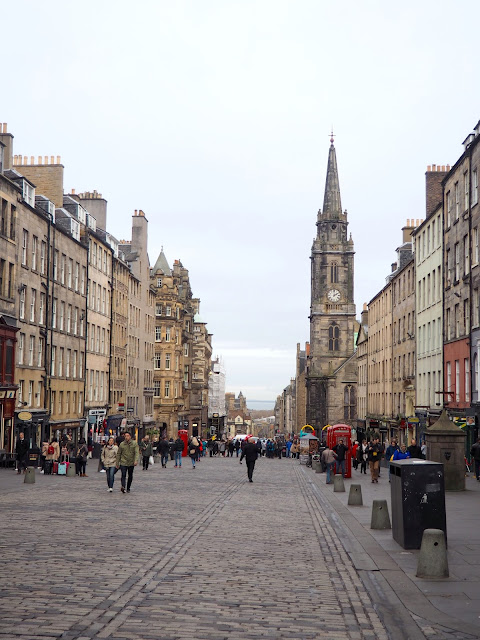
A Week in Australia’s Red Centre
Along with the Sydney Opera House and Great Barrier Reef, Uluru (formerly known as Ayers Rock) has to be one of the most iconic sights in Australia. One of those places I’ve seen photos of forever! It’s not the easiest to get to, being slap bang in the middle of such a vast country. And a very hot, dry desert region of it at that! But I knew I had to include it in my Australia trip and was able to join a small group tour through work. While Uluru may be the most famous, it actually shares its national park with another formation Kata Tjuta. And within a few hours’ drive, you’ll also find Kings Canyon and the West MacDonnell Range. So in total, I spent a week (well, five days) hiking through the deserts of Australia’s Red Centre region.
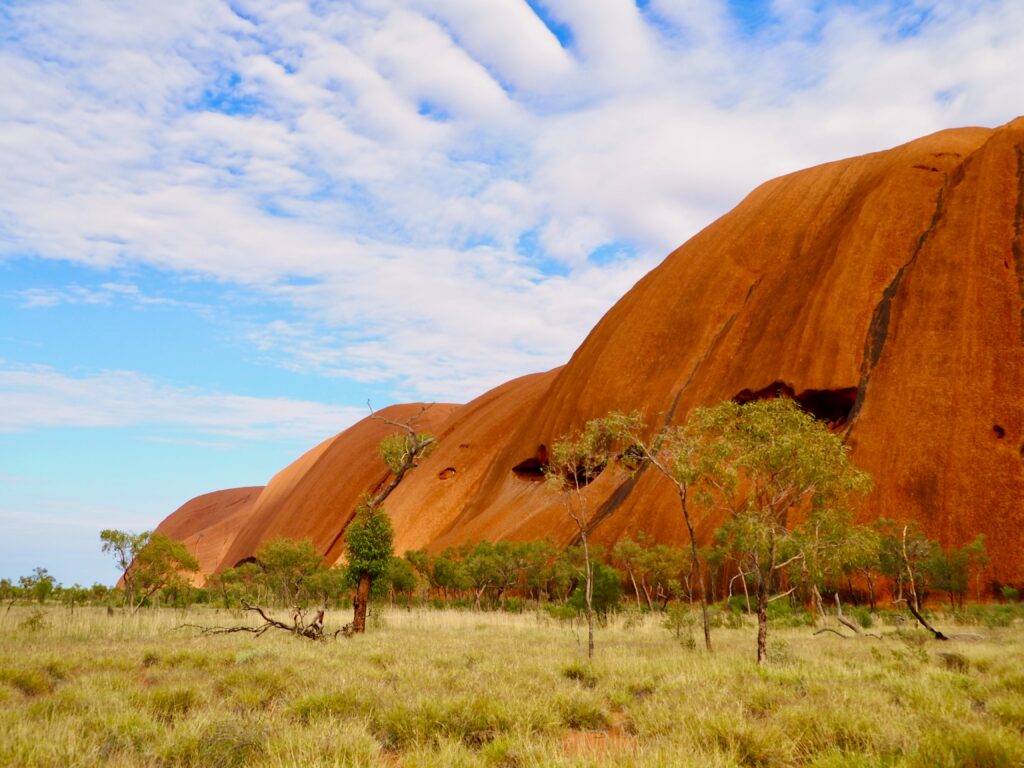
Day One – Uluru
The trip officially started in the late afternoon on Day 1 so you could arrive anytime. Many of the group actually flew into Alice Springs, which has slightly more flight connection options, and drove down with our guide that day. I managed to get a direct flight from Brisbane to Ayers Rock airport that morning, after driving back down from Noosa. All of the accommodation near the Uluru-Kata Tjuta National Park is clustered together in a ‘village’ with complimentary shuttle buses from the airport. As soon as I stepped off the plane, I felt the intense midday desert heat hit me! It was in the mid-high 30s, creeping over 40 by mid-afternoon throughout the week. So we had a lot of very early mornings to hike before it got too hot!
Sunset at Uluru
After meeting the guide and the rest of the group, we headed into the national park for the first time. I’d glimpsed the rock already on the airport bus, but now it was our first proper viewing, for sunset no less. There is a designated sunset viewing area – you can’t just park up anywhere – and we arrived early to stake claim to our spot. It was still early evening so the sky wasn’t that colourful yet, but no matter the time of day, the first time seeing Uluru is magical! It’s so vast, jutting out of an otherwise flat, desert landscape. This ancient monolith, which has weathered the millennia and become such a recognisable image. There’s definitely something surreal and mystical about it!
The sun was setting behind us, casting the rock in its glow, turning it from burnt orange through to a blazing red. The sky stayed fairly blue throughout, with just a haze of pink and yellow along the horizon. But with the green of the desert plants in the foreground, there was truly a rainbow of colours across the landscape! Our guide mentioned that it was unusually green for this time of year, with the foliage normally burning off to brown as summer approaches. The viewing area was pretty busy by now, with many people sipping on drinks – although we were told our group had none out of cultural respect for the Aboriginals, the Anangu people, who regard this as a sacred site. We did bring nibbles though! Once the sun had set and the rock lost the glow, we headed back to our hotel for the night.
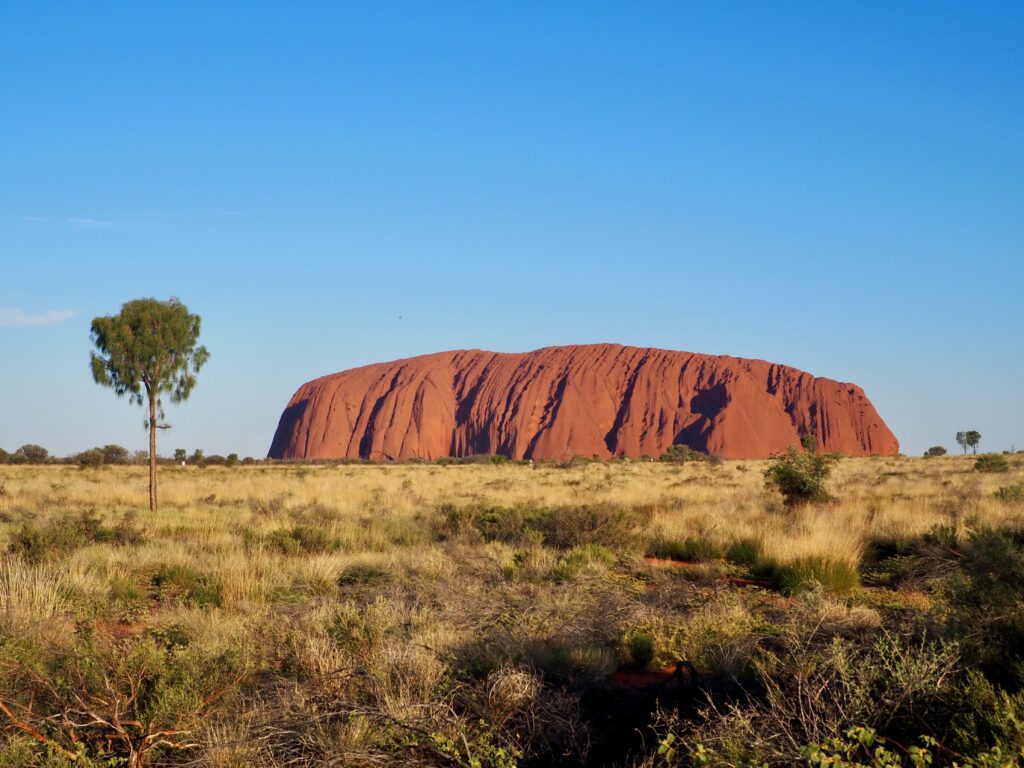
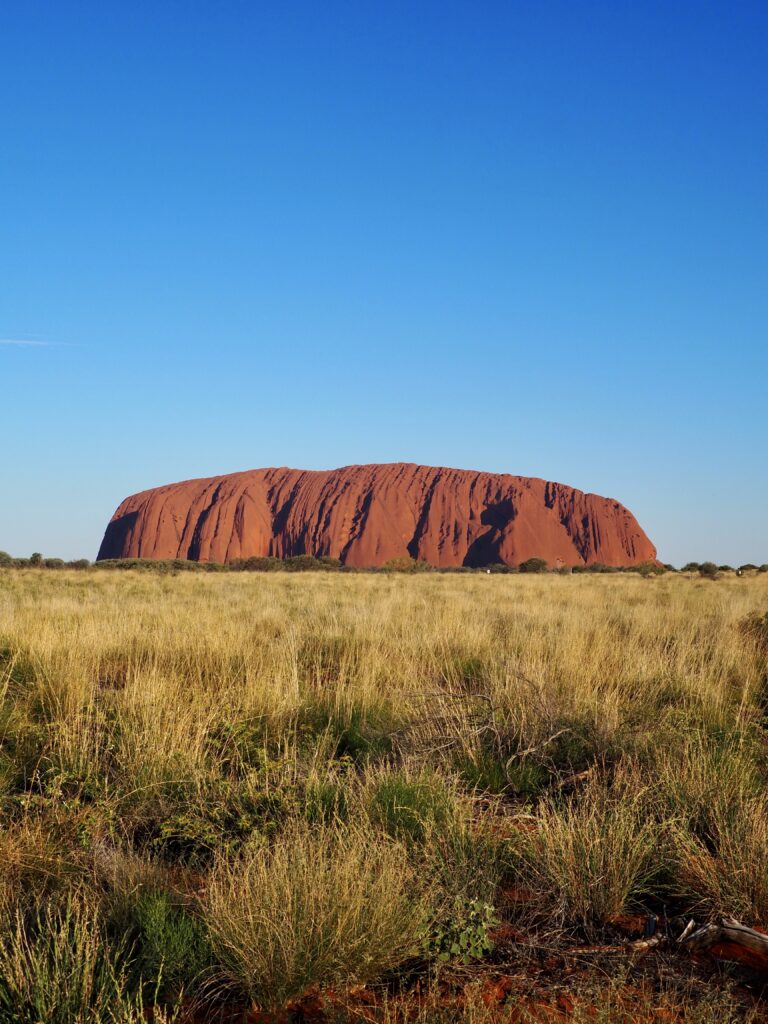
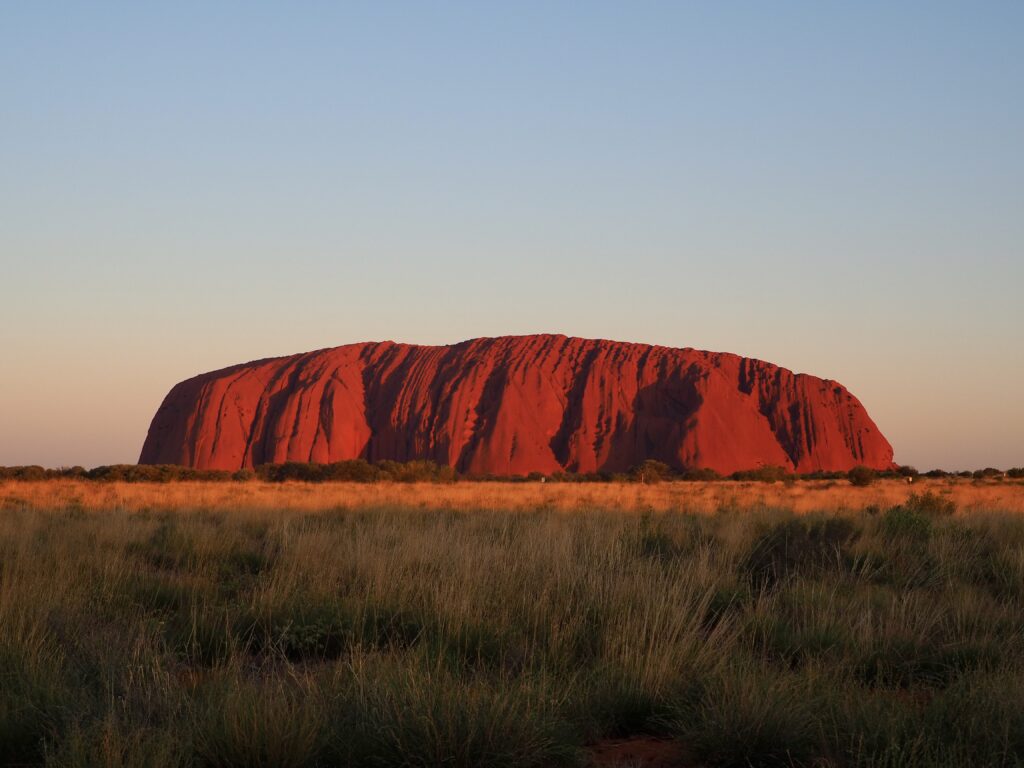
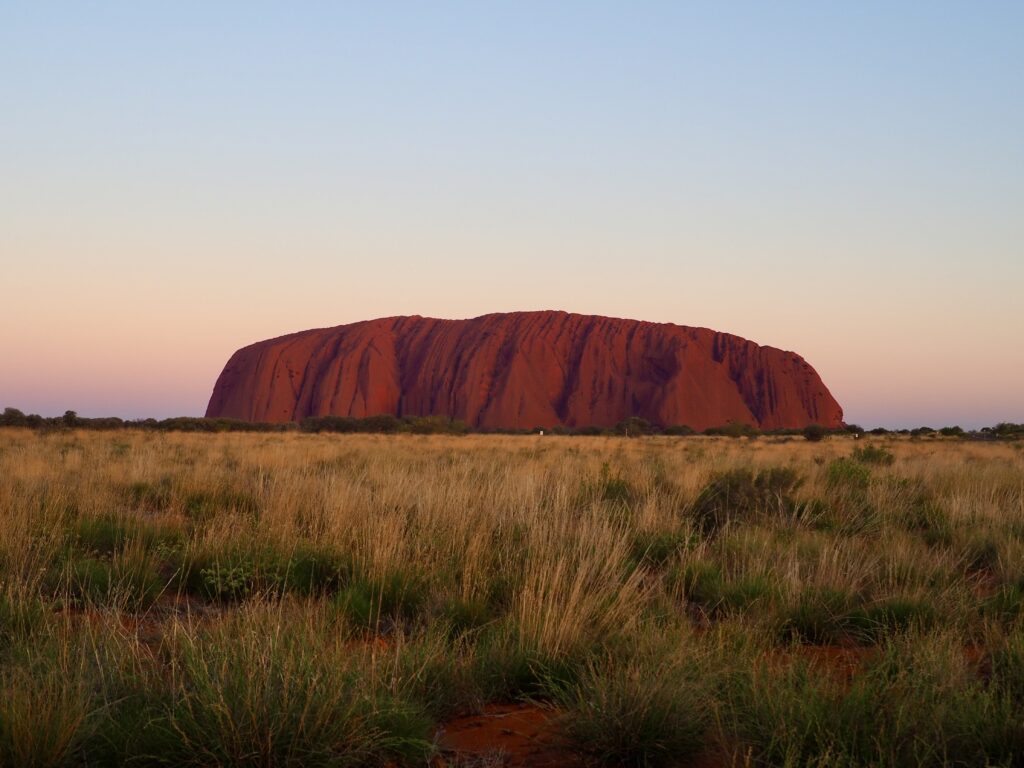
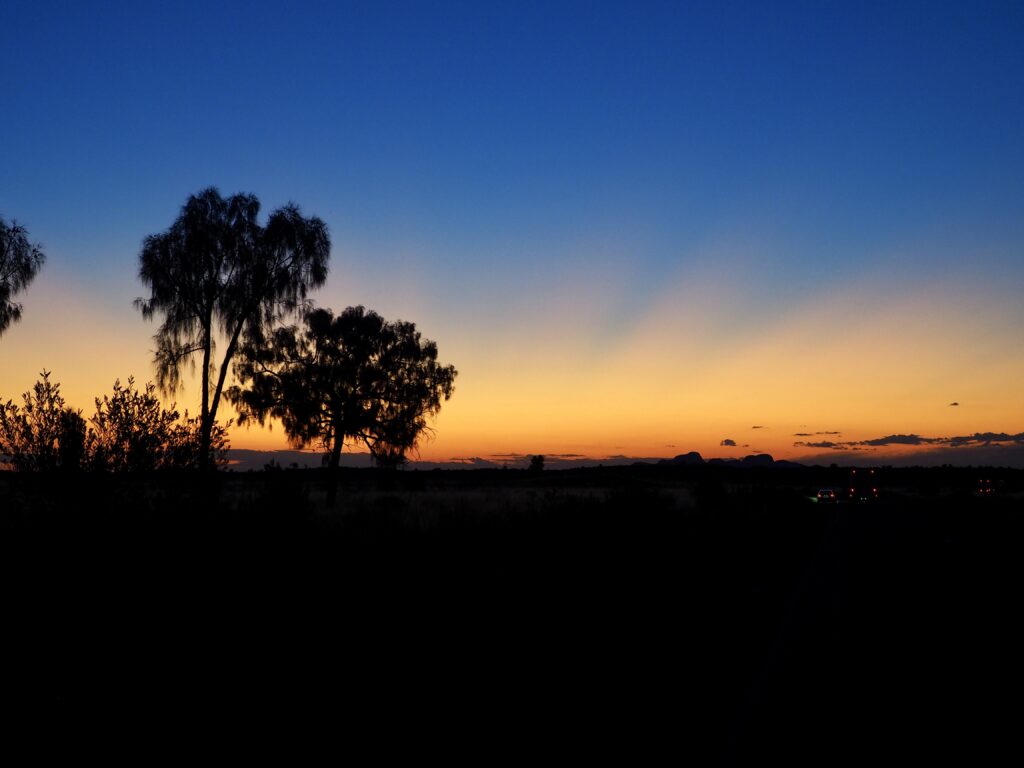
Day Two – Uluru-Kata Tjuta
Sunrise at Uluru
A short night however, as we were up at around 4.30am to head back into the park for sunrise! Again, there is a specific viewing area for this, which has stairs and boardwalks to raise you higher up above the land, allowing more of that desert foliage in the foreground. And again, the sun was rising behind us to cast its glow on Uluru, so we were on the other side of it now. We arrived while the sky was still dark but it slowly turned purple as dawn began to approach. The moon was hung just above the rock, a dazzling white spark in the violet sky.
Streaks of pink began to dance along the horizon and if I turned around I could see the desert trees silhouetted against the orange of the sunrise beginning. I took a wander down from the boardwalks to the paths through the desert below. As the sun emerged, Uluru lit up again, glowing red in the dawn light. This also illuminated the wildflowers scattered underfoot, yellow and purple and white peeking out, so delicate and small in the harsh Australian outback! Like the night before, I was amazed at the array of colours around me, as the sky turned blue once more, a striking contrast to the red and orange of the land.
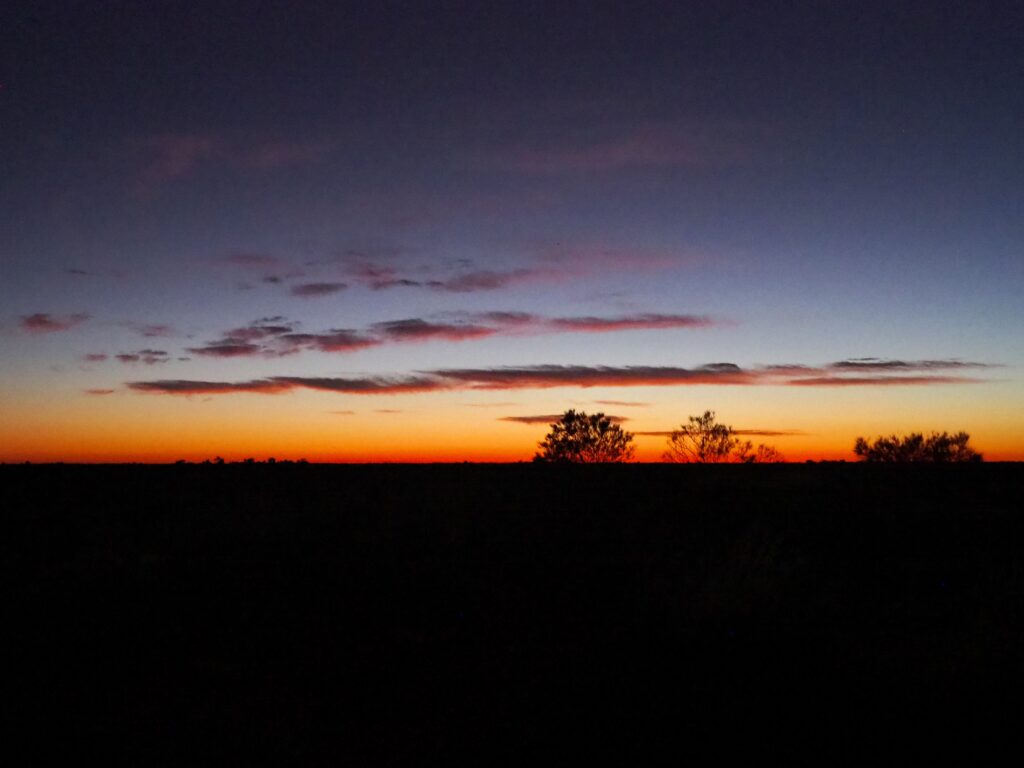
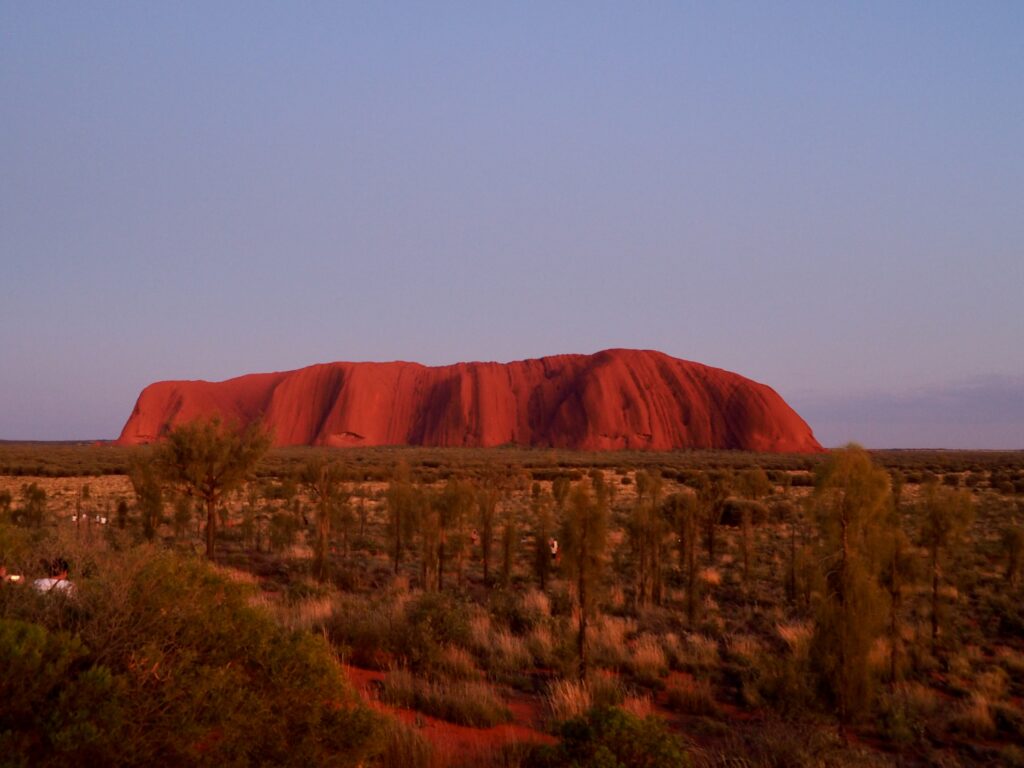
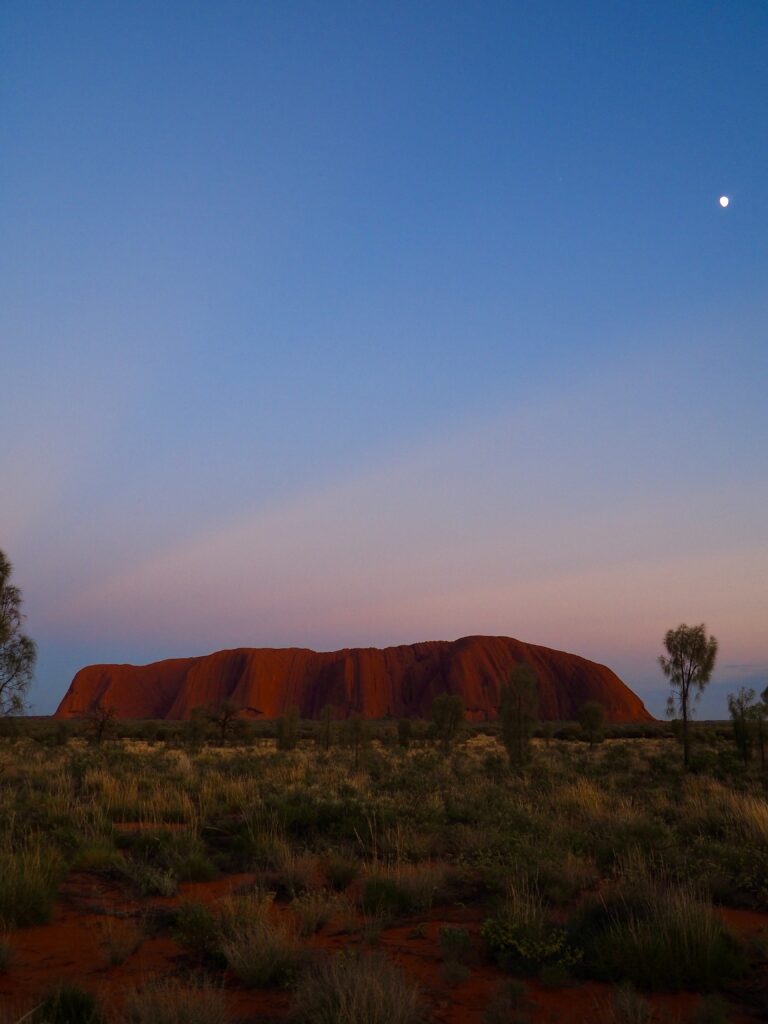
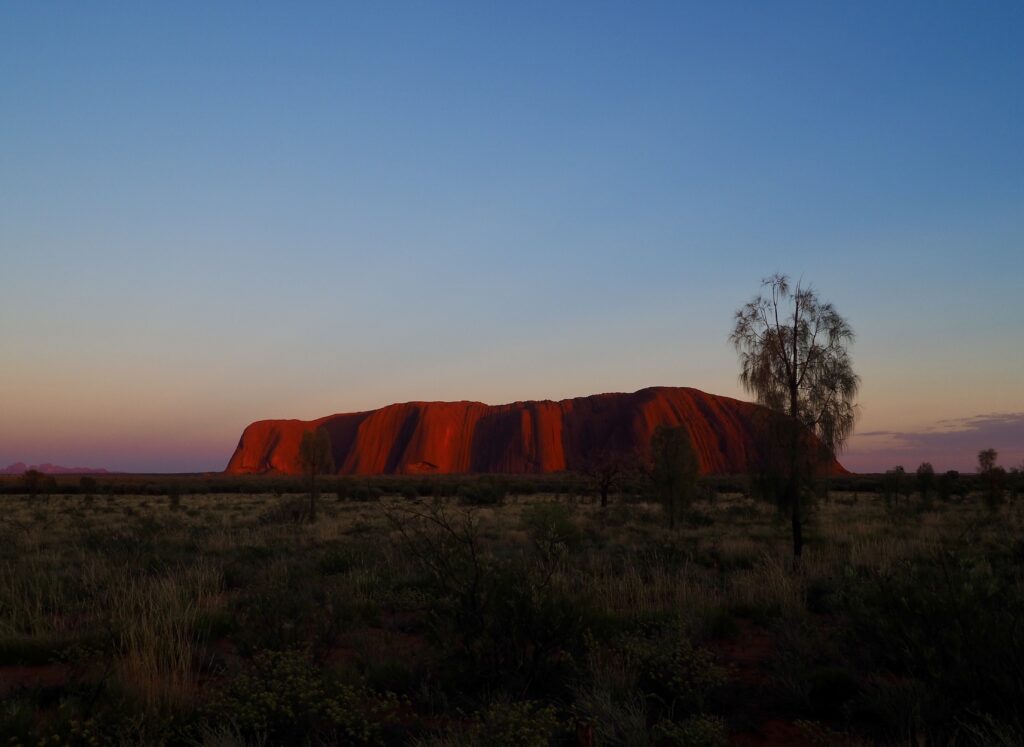
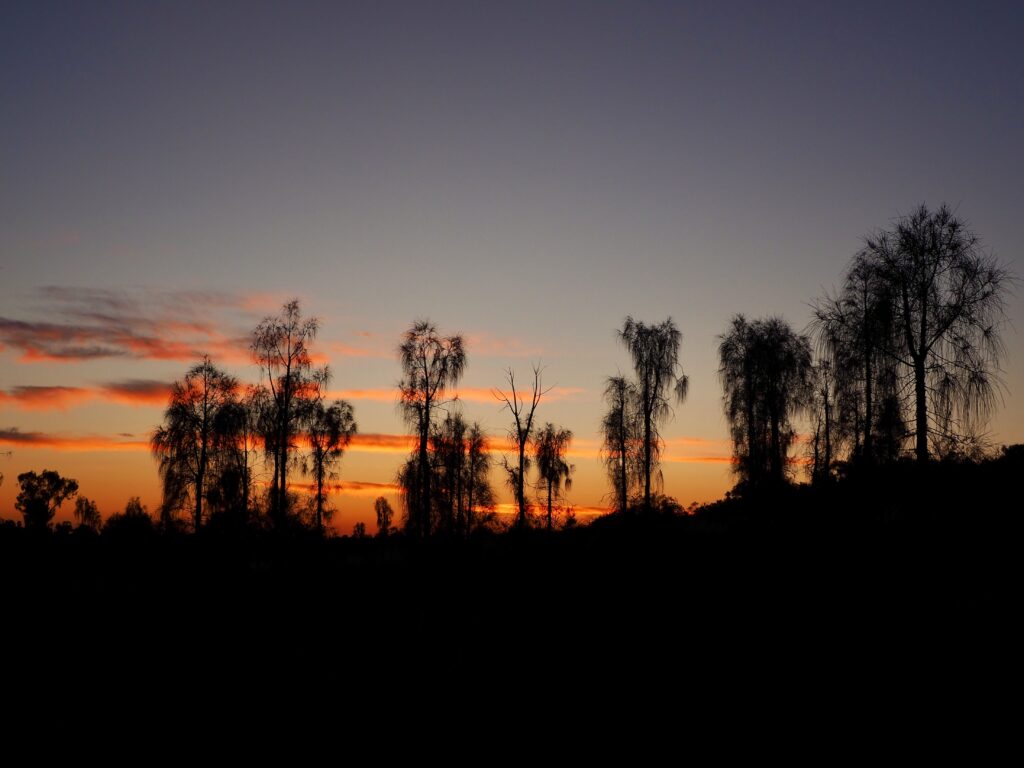
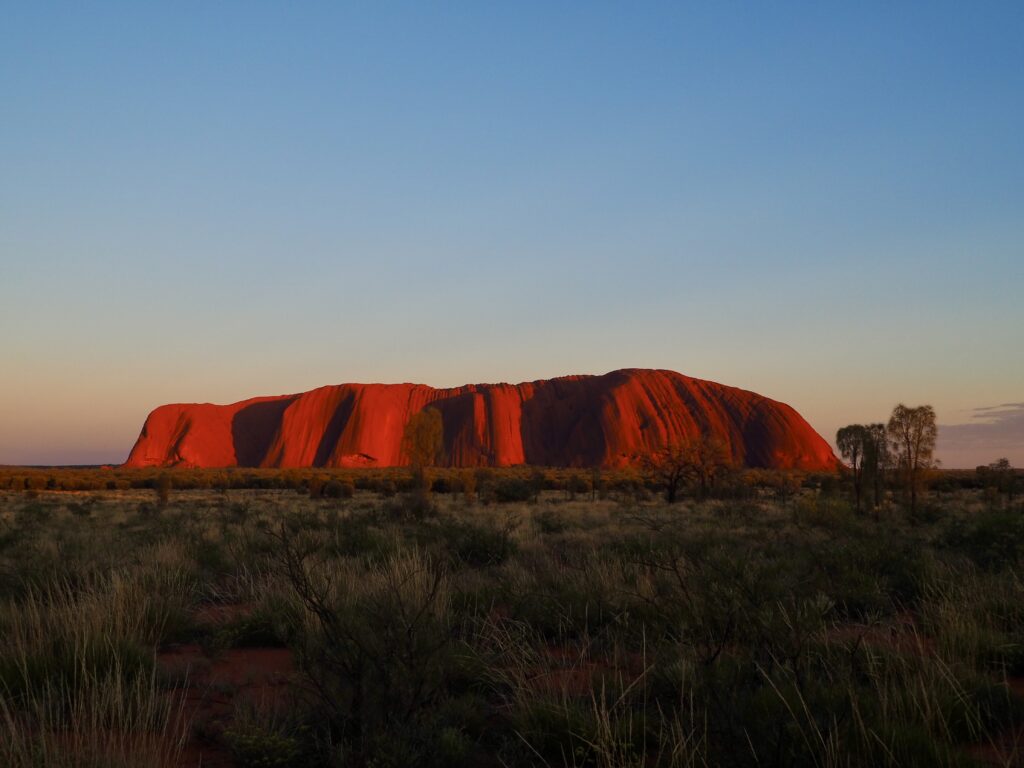
Mala Walk & Kuniya Walk
After breakfast, we squeezed in a couple of short walks this morning. Both were near the base of Uluru, the Mala Walk and then the Kuniya Walk which leads to the Mutitjulu waterhole, and each had a story to go with it. The Anangu have many Dreamtime stories about Uluru, particularly its shapes and patterns. In their culture, this knowledge is earned as you grow older. Hence their Elders are greatly respected for their vast wisdom. They have chosen to share a few of their stories with visitors, the simple children’s versions, to educate them on this sacred site. Though there are many more, and more complex versions, that they choose not to share!
Each walk was fairly short, and the leafy green desert oaks offered shade along the way. The waterholes found around Uluru’s base are incredibly value, but many of the desert plants also contain vast reserves of water in their trunks. So while it may seem like a dry environment, impossible to live in, there is actually water everywhere if you know where to look! There were some ancient rock paintings and cave-like openings which had different purposes in Anangu culture. We even got close enough to get to touch the rock itself, which I was very excited about! We also saw the spot where people used to climb Uluru, before that was halted a few years ago to preserve the sacred rock. It looked very steep and quite scary to me anyways!
Cultural Centre
Our last stop this morning was the Cultural Centre, for a further look at the Anangu culture. The exhibits told the same stories our guide had talked about on the walks this morning. But like with any stories passed down primarily orally, it’s always interesting to read or hear slightly different versions each time! We also arrived in time for a talk, where the guide also told us a lot about how people survive in this desert outback environment. The Anangu have lived out here for millennia, passing down their knowledge to each other, so it’s important to continue to preserve that knowledge. Though much of it remains known only to them.
The centre also has a cafe and shop, and a gallery of dot paintings, which a few Aboriginal women were also working on while we browsed. The whole thing is a newer addition to the park and I think it’s definitely a worthwhile stop. Especially if you’re not on a guided tour like I was, then it’s a great way to learn about the local culture. Then it was time to get indoors back at the hotel for a few hours, escaping the mid-afternoon heat!
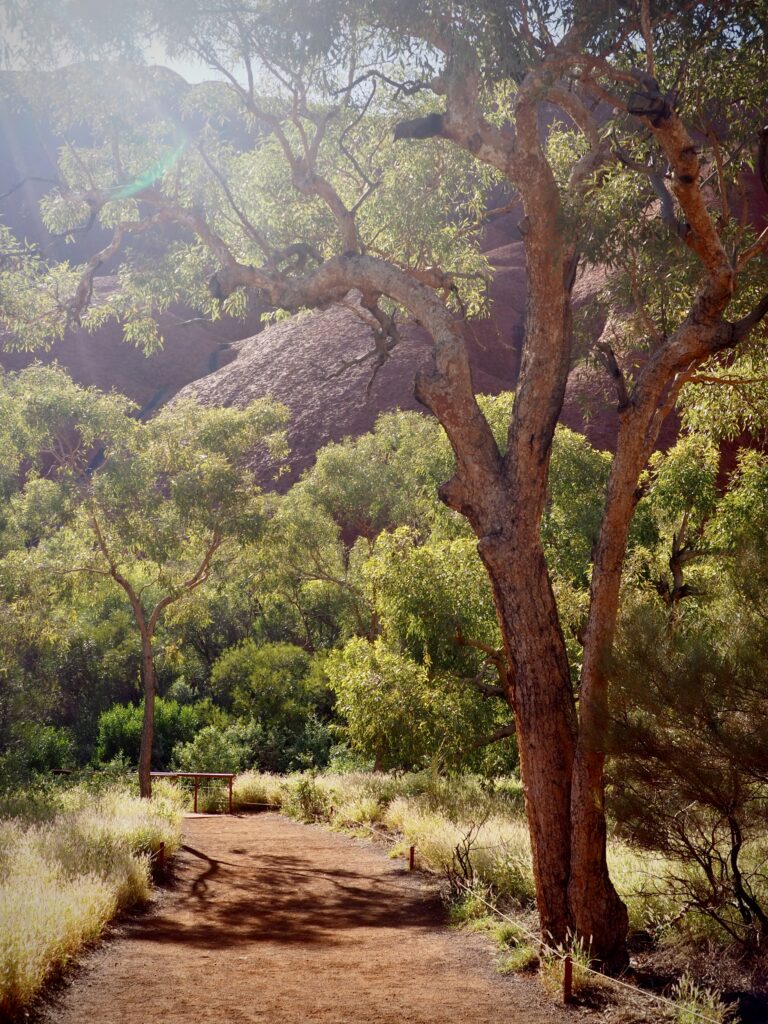
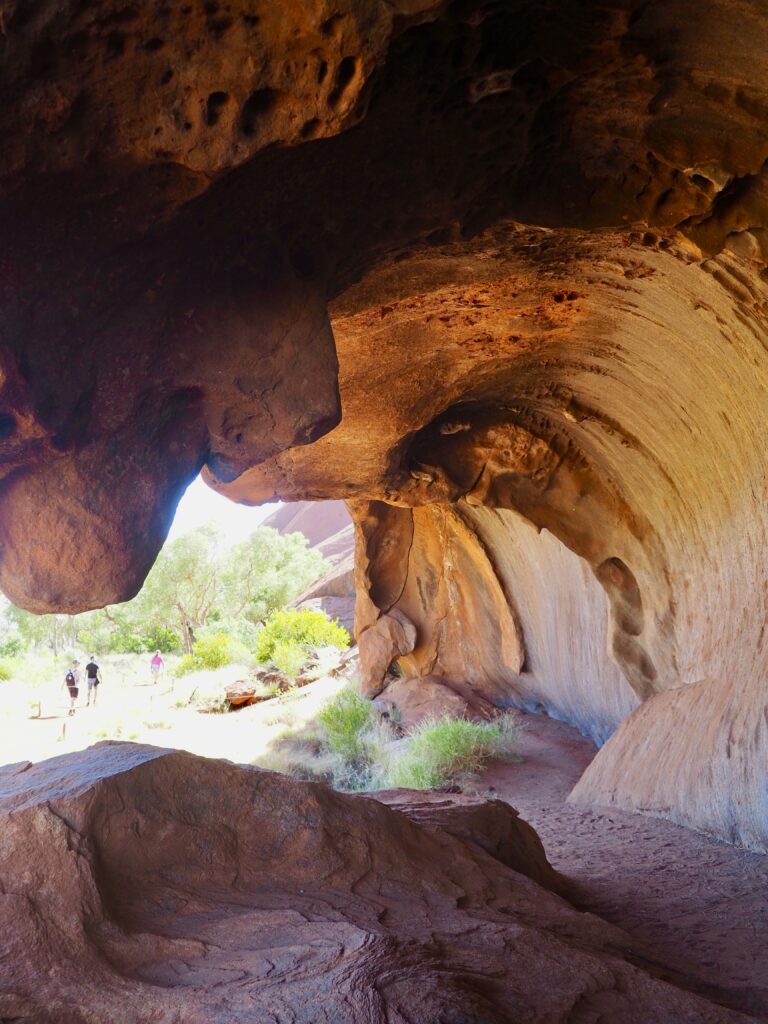
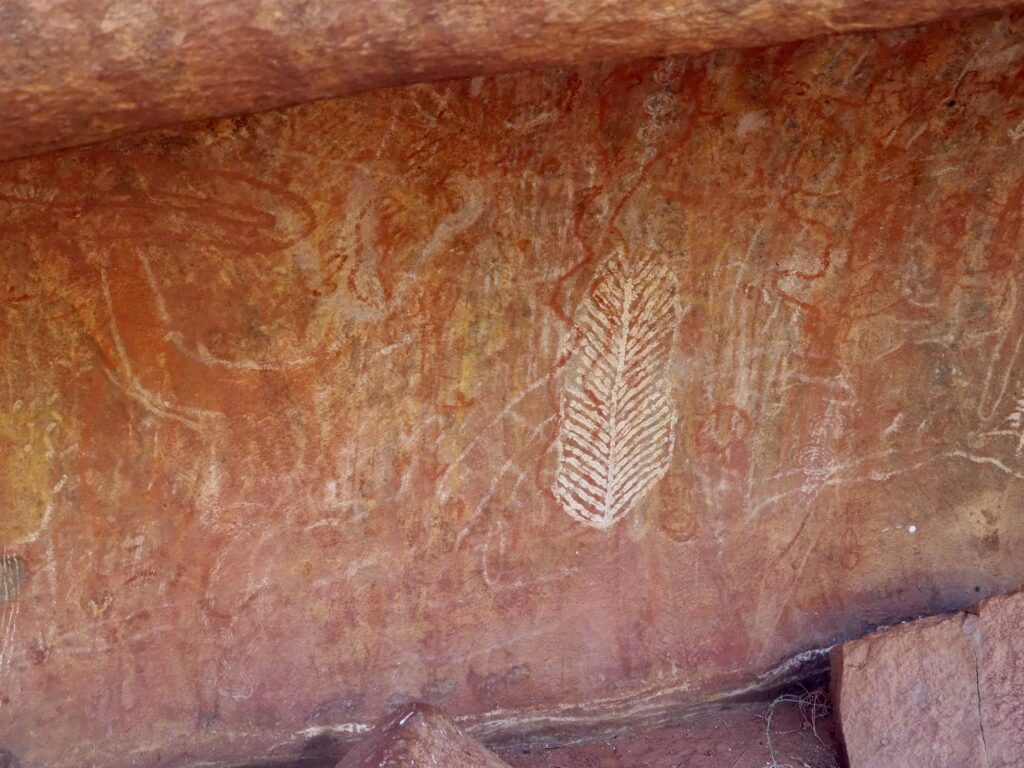
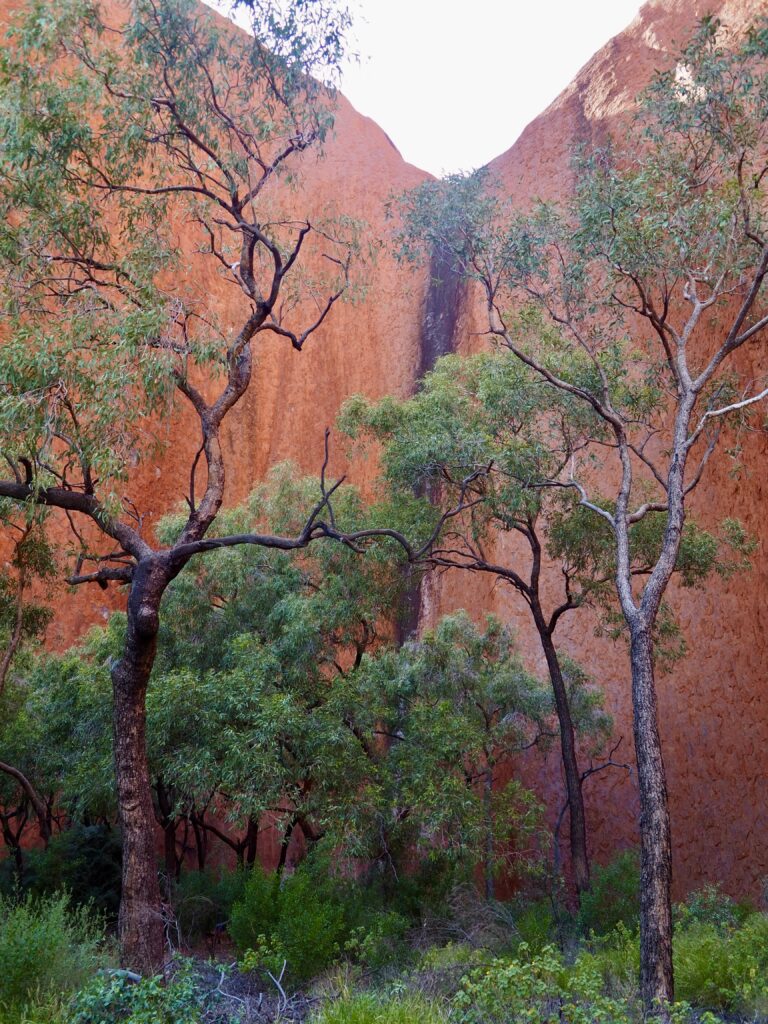
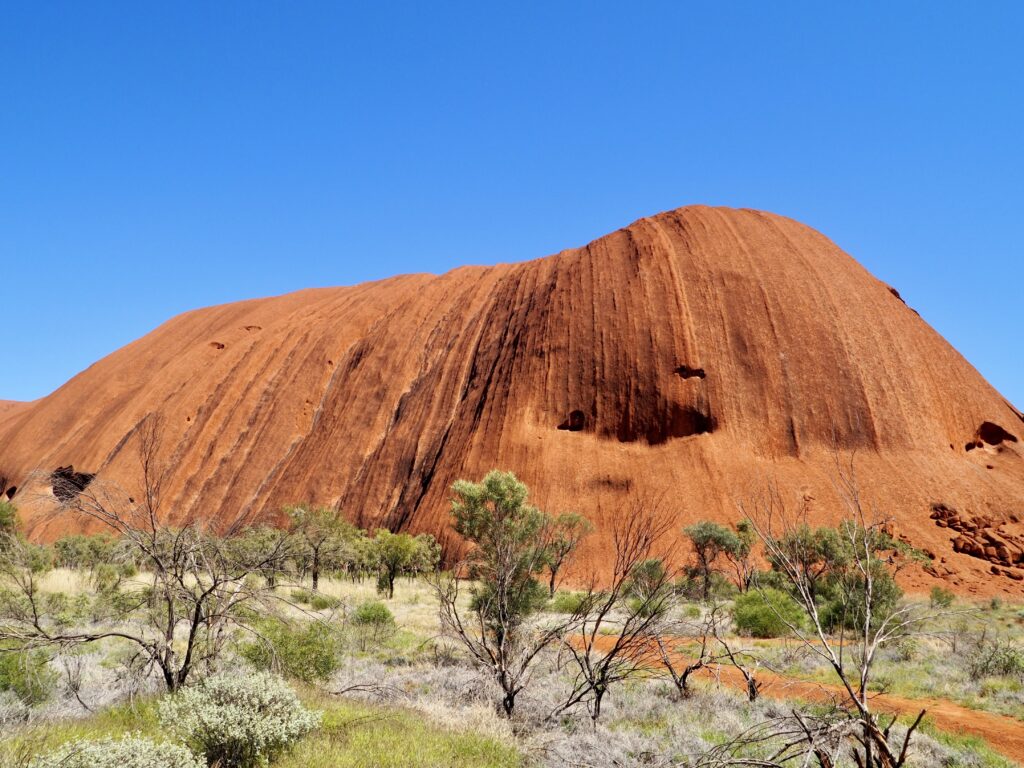
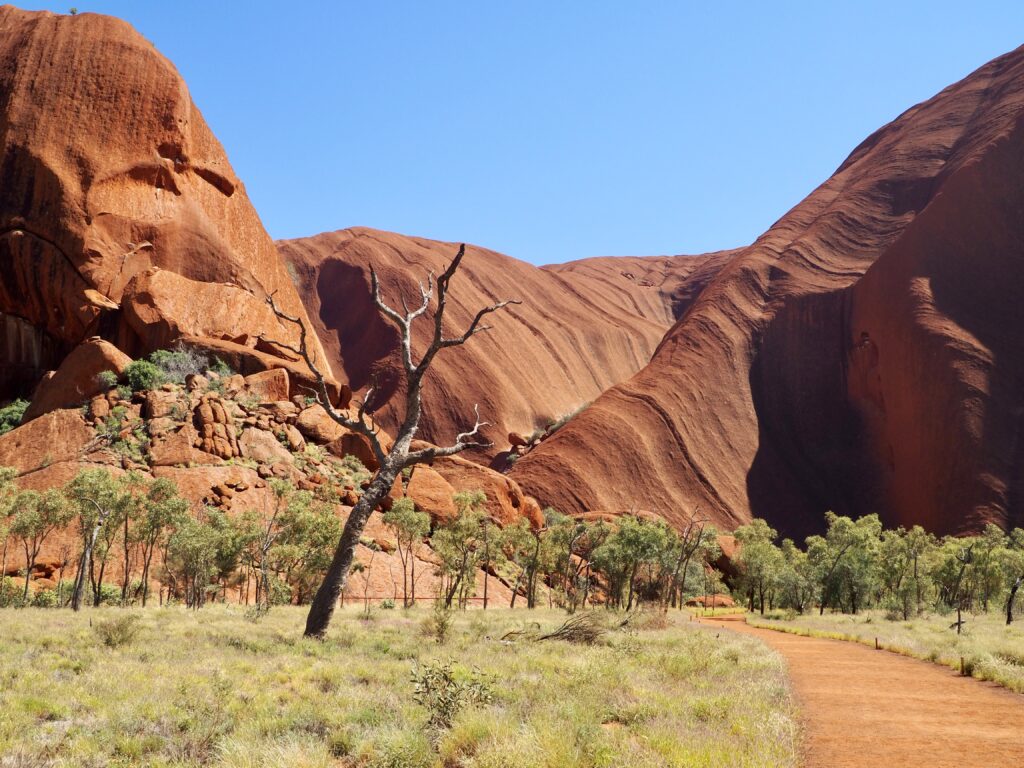
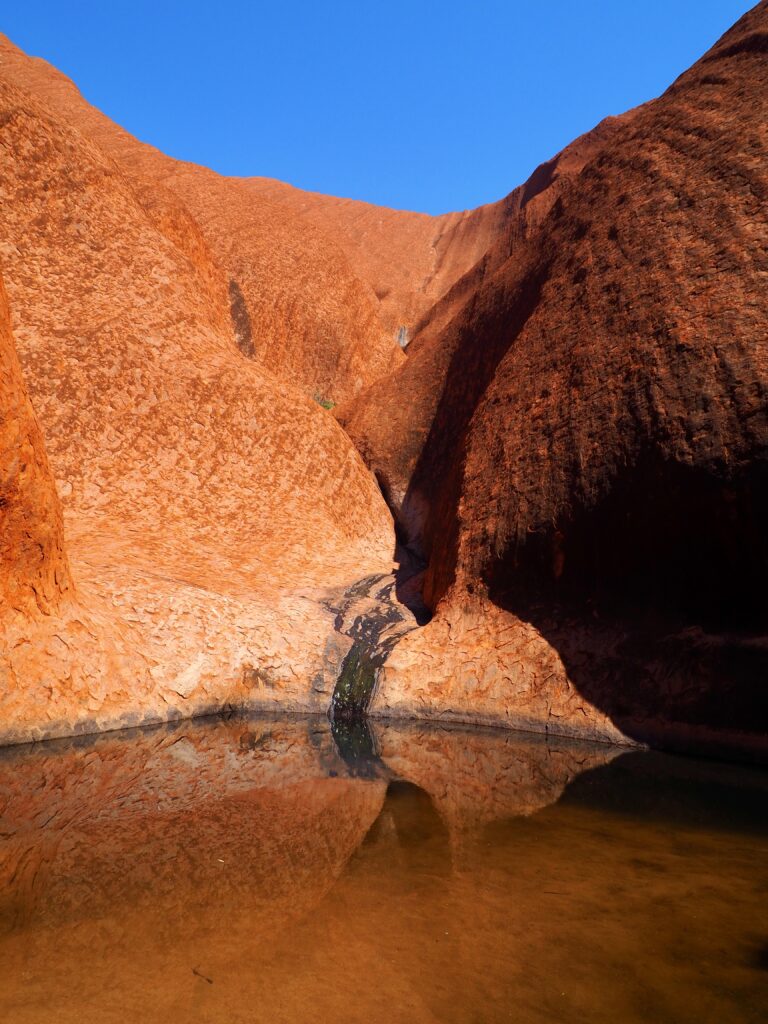
Kata Tjuta
Later in the afternoon, we headed to a different area of the park. Uluru-Kata Tjuta National Park is named after its two massive rock formations, though the second is not quite as well known. Kata Tjuta was named the Olgas by Europeans. But like how we’ve switched from Ayers Rock back to Uluru, Australia is trying to revert to Aboriginal names. It’s another massive, red-coloured monolith rising from the flat, desert landscape. But where Uluru is one fairly even, tabletop-like rock, Kata Tjuta is a little lumpier and bumpier! We made a stop at a viewpoint on the way over to see the whole thing from a distance. It almost looks like a mountain range, with rounded peaks and undulating curved gorges between.
Walpa Gorge Walk
This is a sacred men’s site for the Anangu, used for cultural activities they don’t share with outsiders. So, only a couple of walking trails are open to visitors. We headed to Walpa Gorge, an out-and-back trail through a green valley between the rocks. And I do mean green! I’ll probably keep repeating this but I was amazed at how vibrant the plant life was on these hikes. I kept stopping to take photos of all the different desert wildflowers too! The contrast between them and the massive gorge rock walls on either side of us was incredible. The trail was fairly easy and not super long, ending on a little platform looking back out the gorge.
We had planned to watch sunset glowing on the rock, like we had with Uluru the night before. But we were enjoying seeing the sunset in front of us for a change, casting the desert landscape in the evening light. There was only one other hiker on the trail with us too, making it a very peaceful spot (quite the contrast to last night!). We decided to stop back near the entrance of the gorge instead, watching the sun set on the horizon, while still getting to see the rocks surrounding us glow red. Being out here in Australia’s Red Centre, so far from the big cities, and with so few people around, in a vast, ancient landscape was pretty humbling.
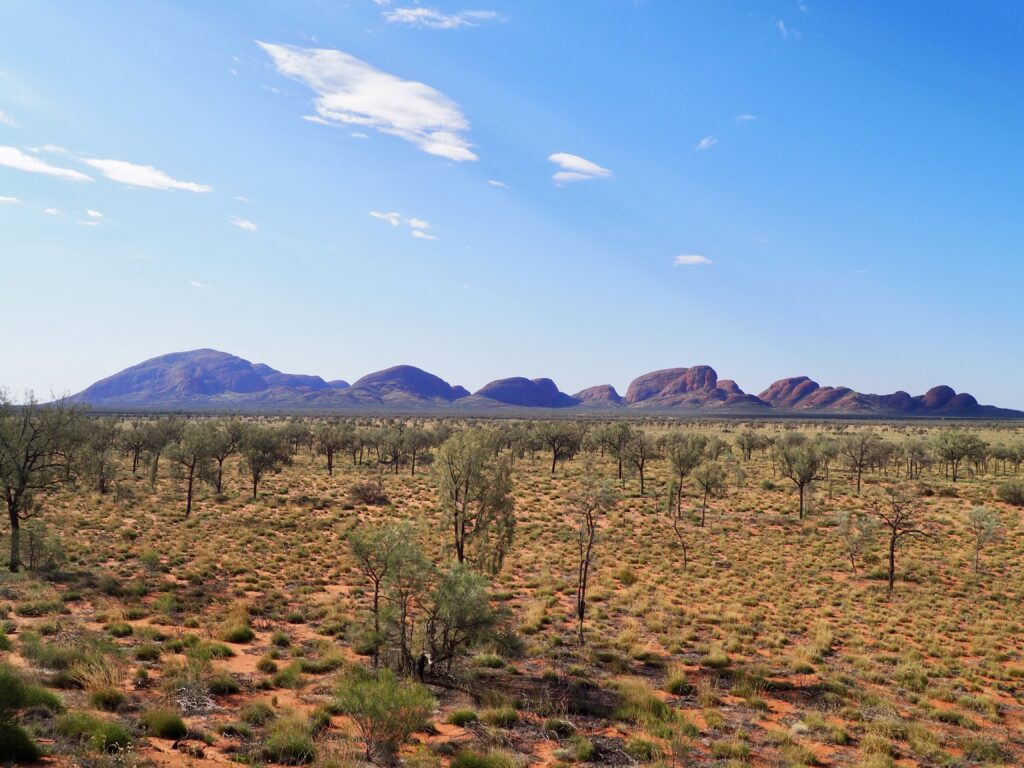
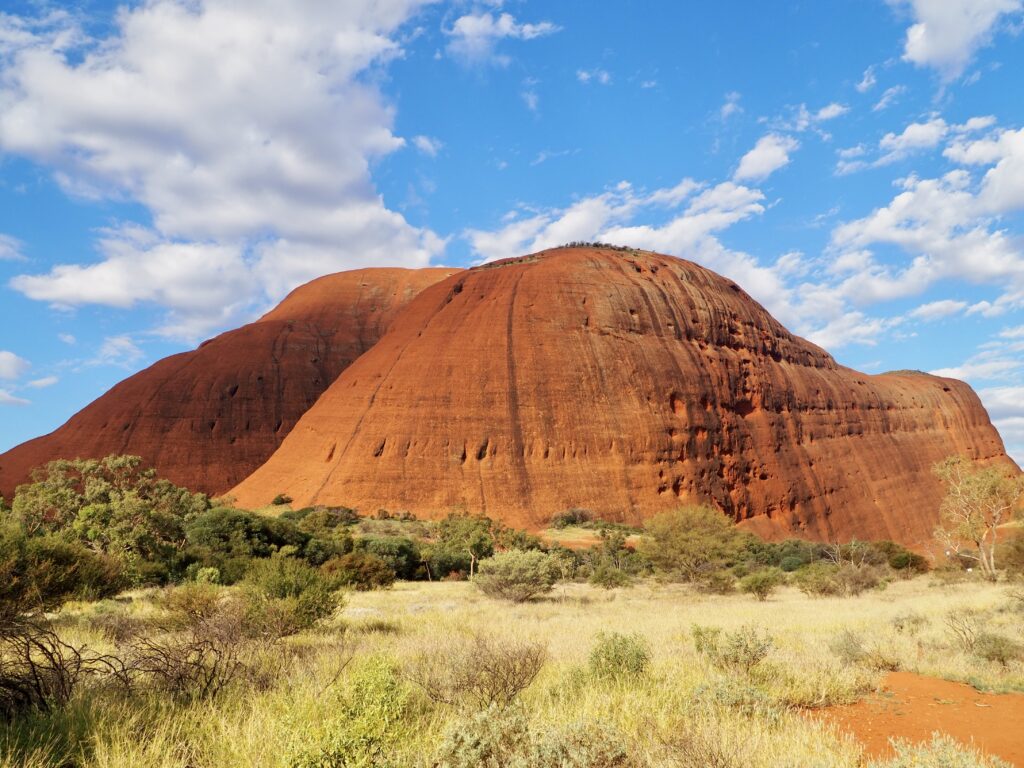
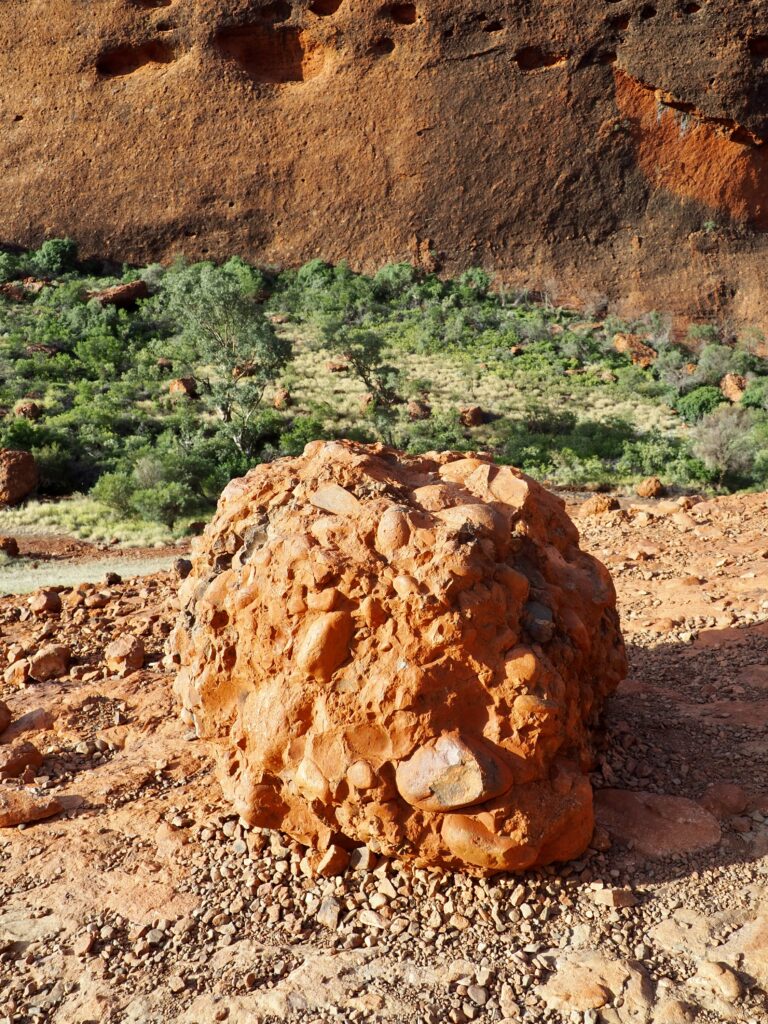
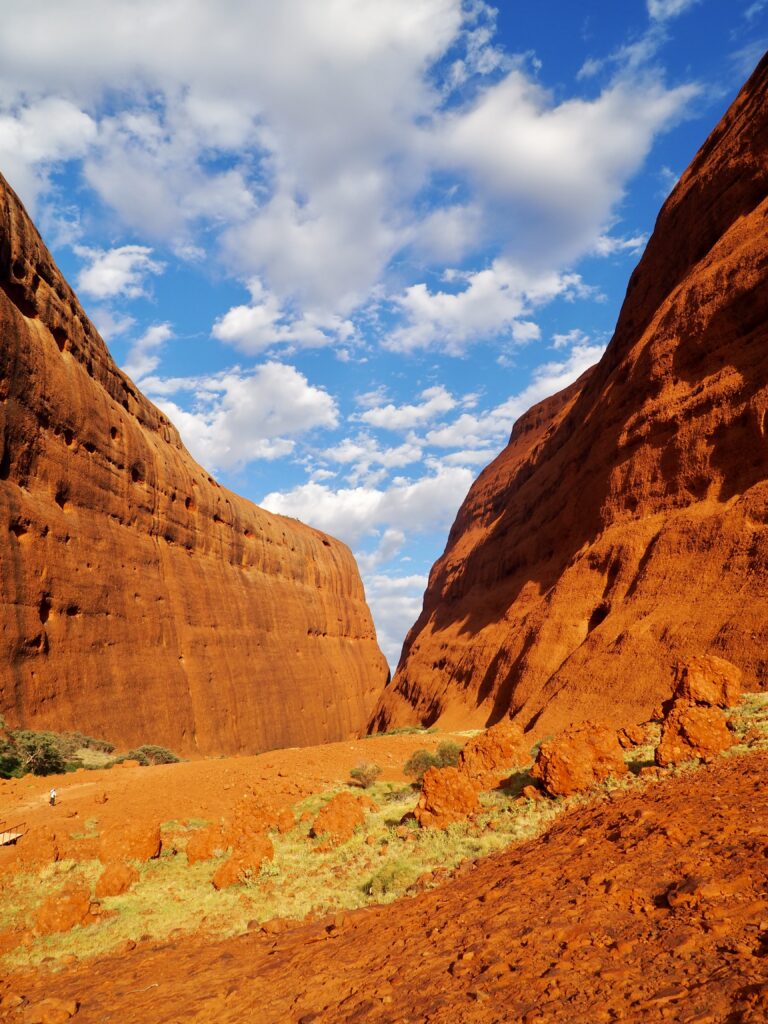
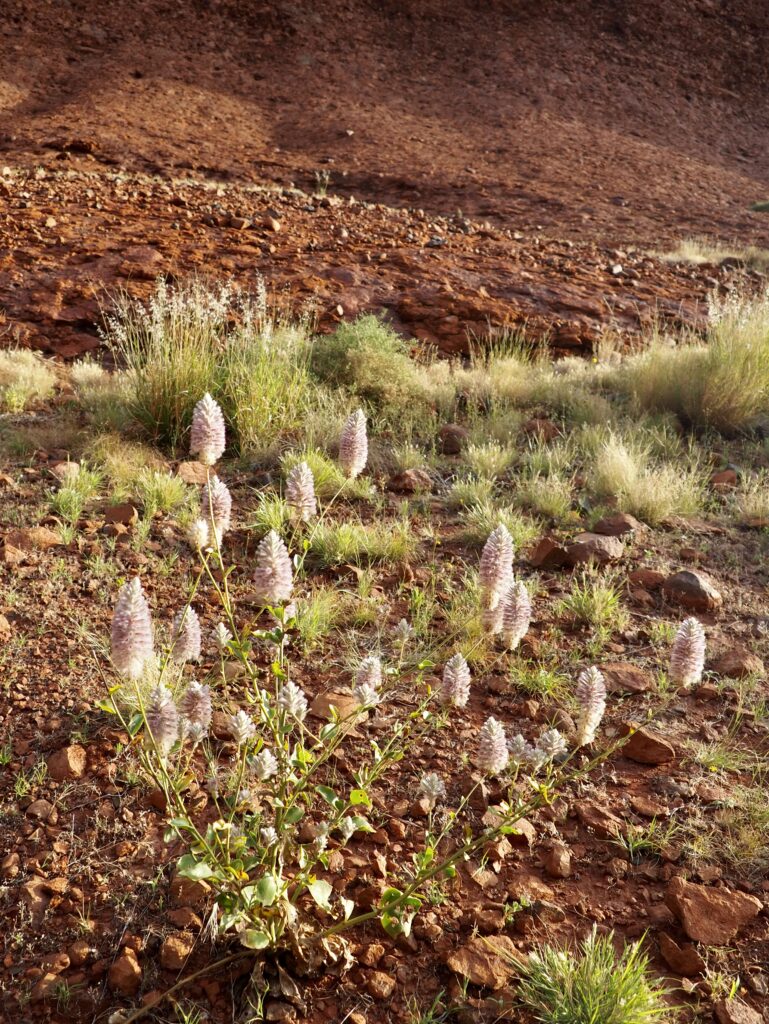
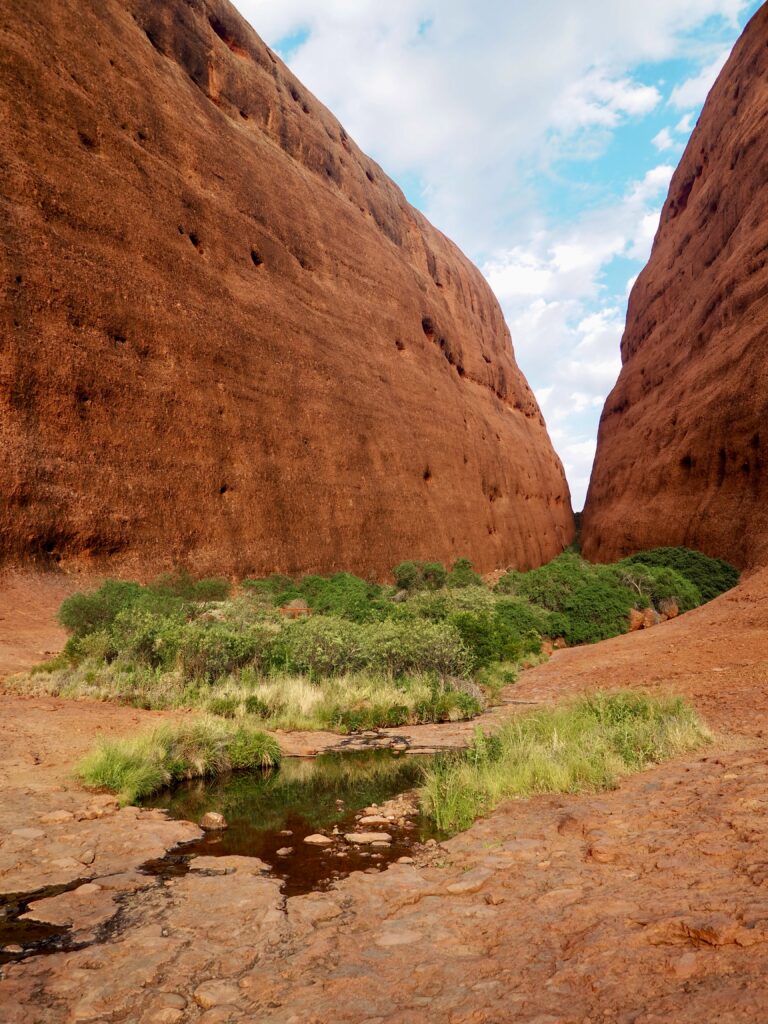
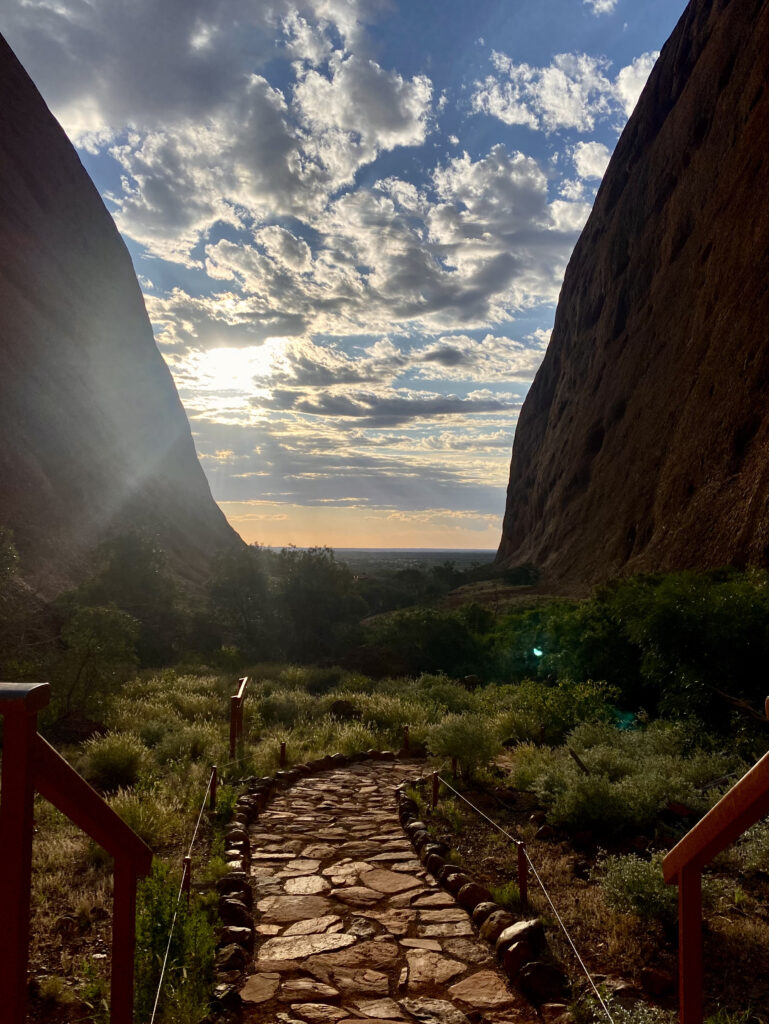
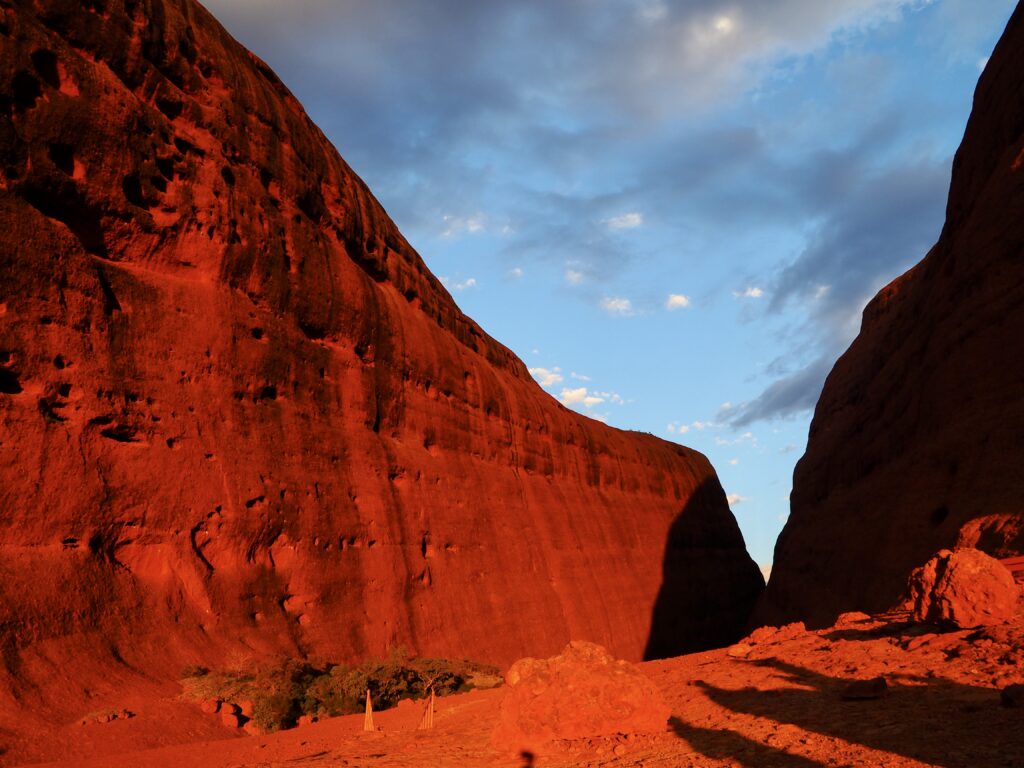
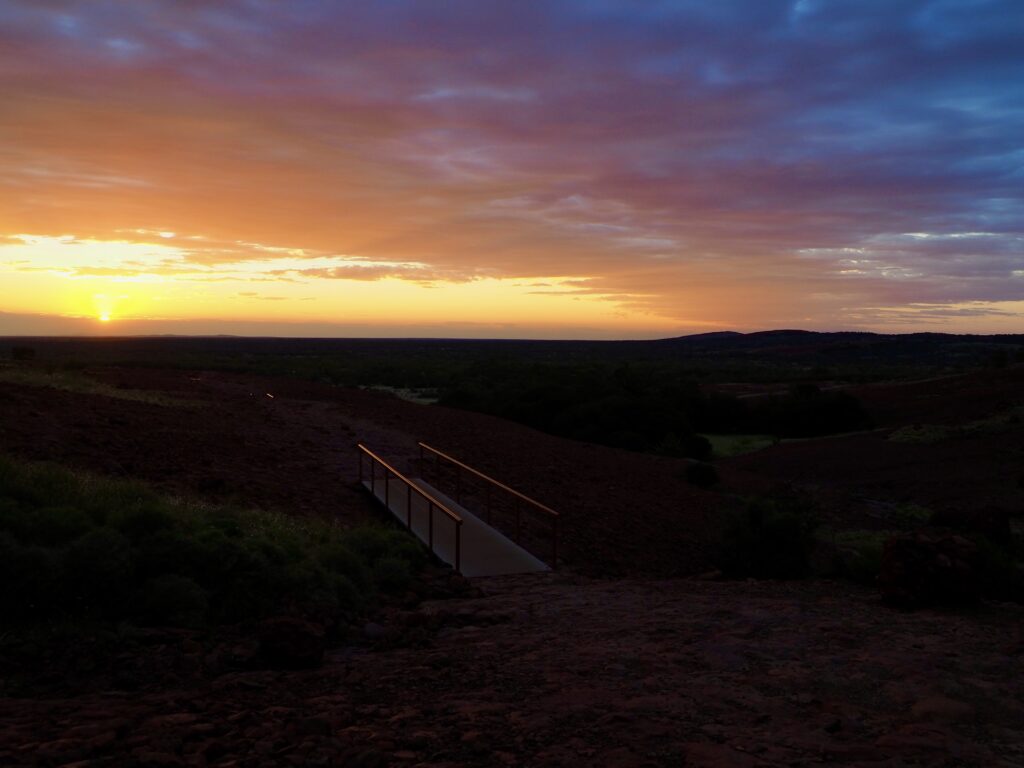
Day Three – Uluru to Kings Canyon
Uluru Base Walk
For our last morning at Uluru, we were up early again to beat the heat for our longest walk so far. As the name suggests, the Uluru Base Walk takes you around the circumference of the rock. It’s around 10km and averages 2-3 hours. It was a bit cloudy that morning, a rarity here, which was ideal sun protection! Stretches of the walk were also surrounded by trees, again so much greenery in such a dry, hostile land, and provided more shade.
Our guide acted as a support vehicle, driving ahead to wait with water top-ups and snacks. He let everyone go at their own pace, so the group slowly stretched apart then met again at the end. This meant I walked solo mainly. I felt I could take in more of my surroundings and appreciate where I was in this moment without being distracted by conversations. There was plenty of time for chatting with the group during the rest of the trip! It’s a fairly easy walk too, being flat all the way around.
Walking all the way around the rock allows you to see all its variations. Some parts had striations running down vertically; others were rounded domes; others were adorned with crater-like depressions. Large horizontal slices were missing as if they’d been carved out. One side has a green-ish discolouration like reptilian scales. While it may look like a big red rock from afar, there is so much more going on up close. Which probably accounts for the sheer volume of photos I have! A few sections cannot be photographed, out of cultural respect for the Anangu as well. It felt like a great achievement to have completed the entire circuit.
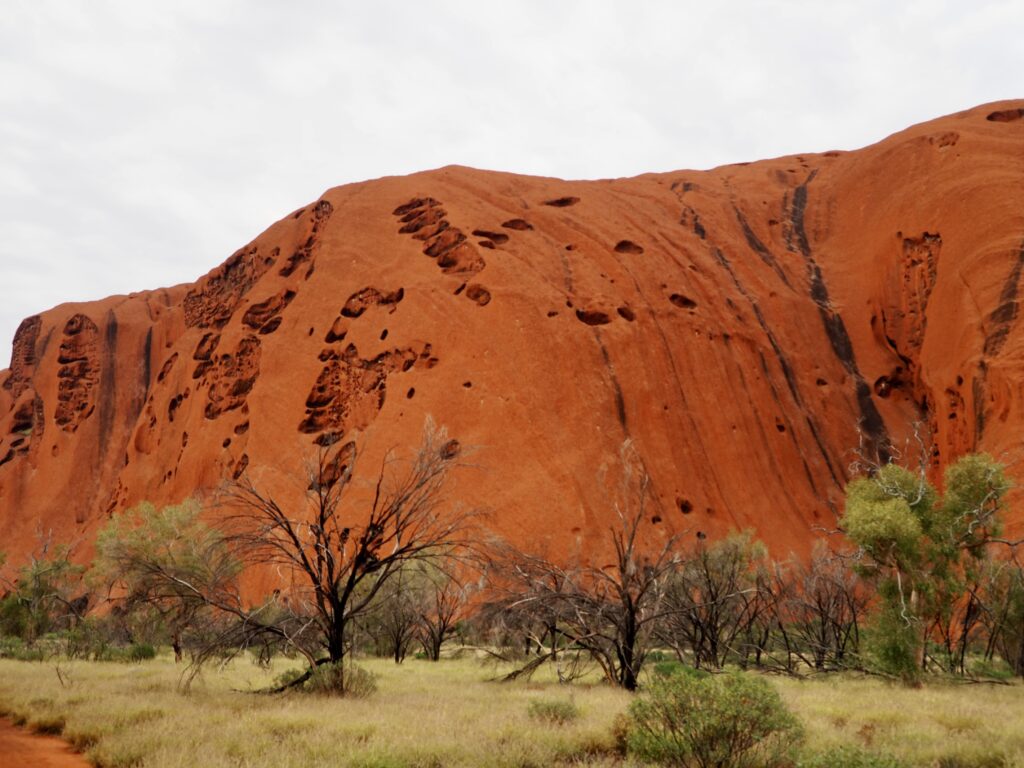
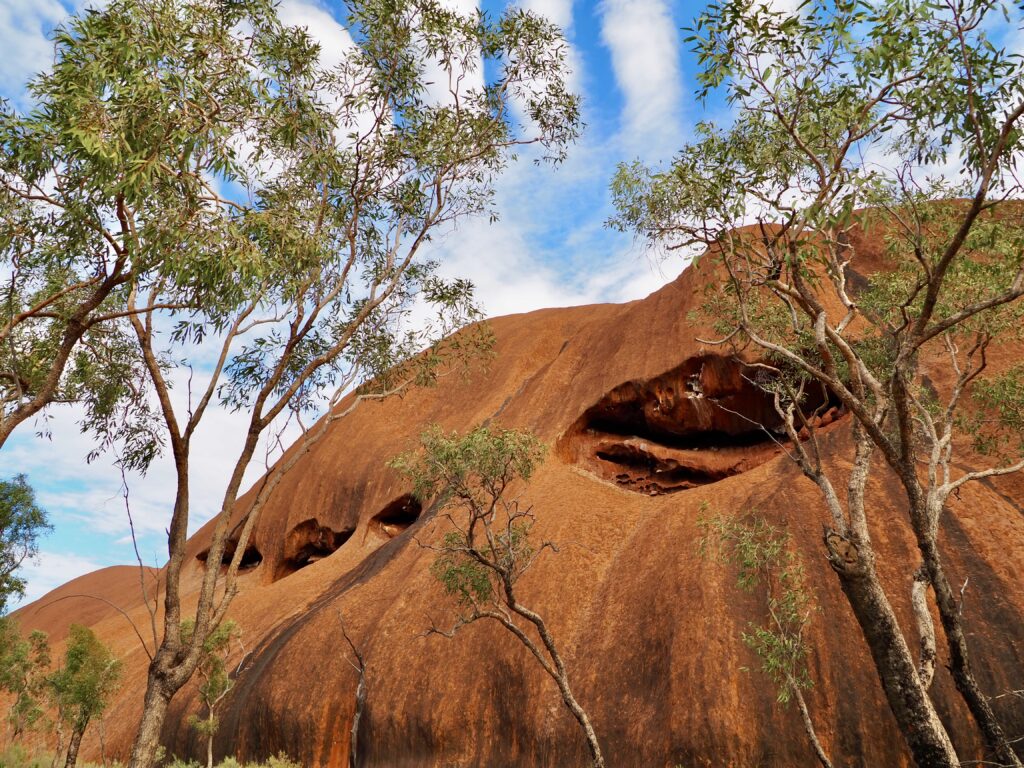
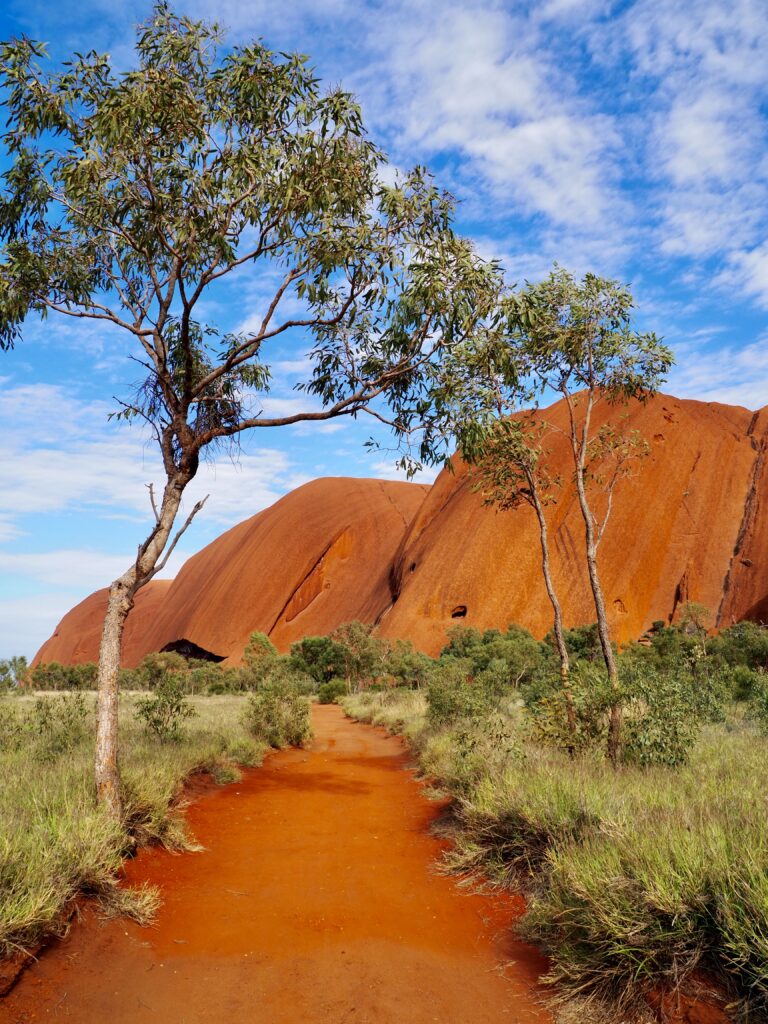
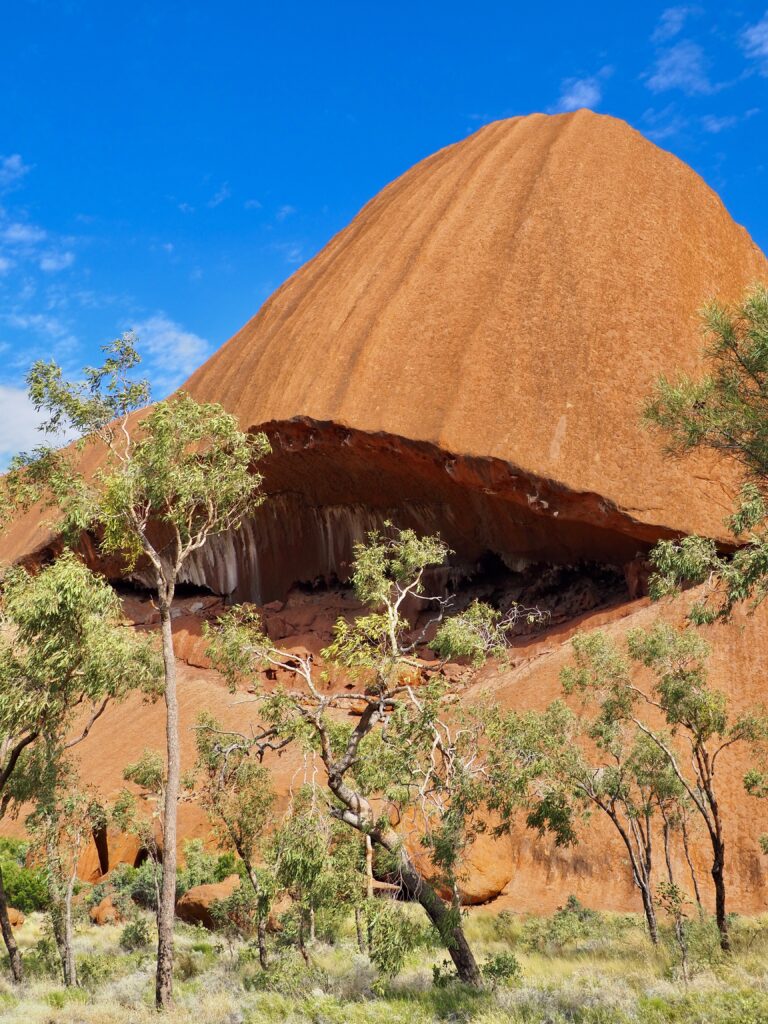
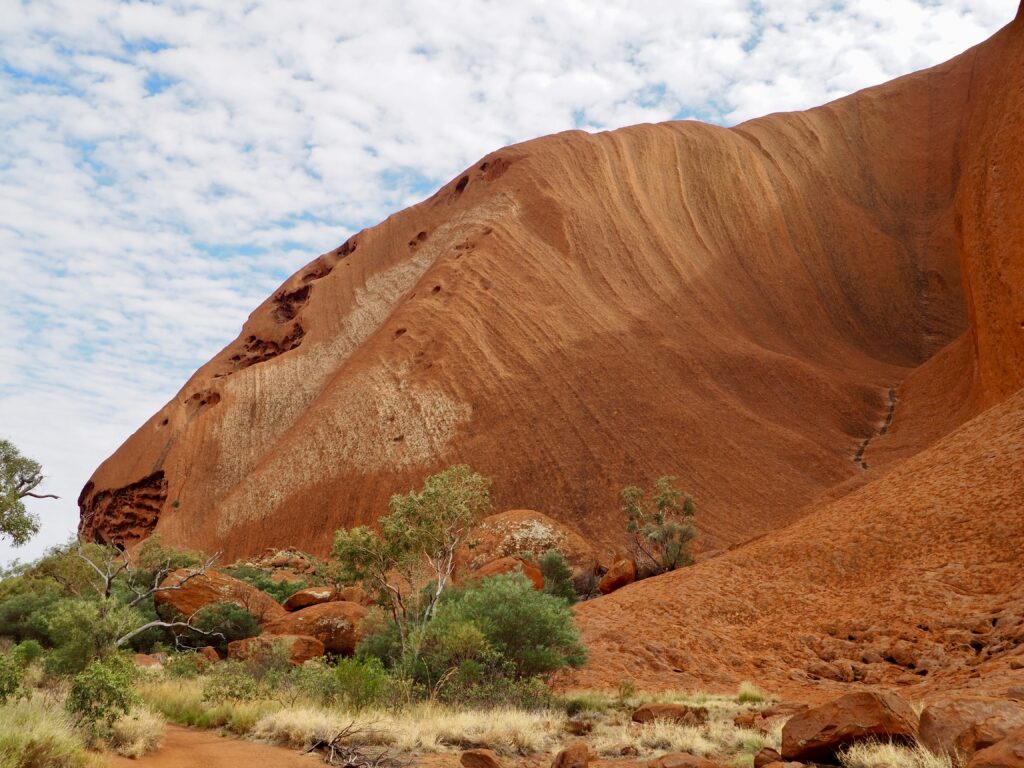
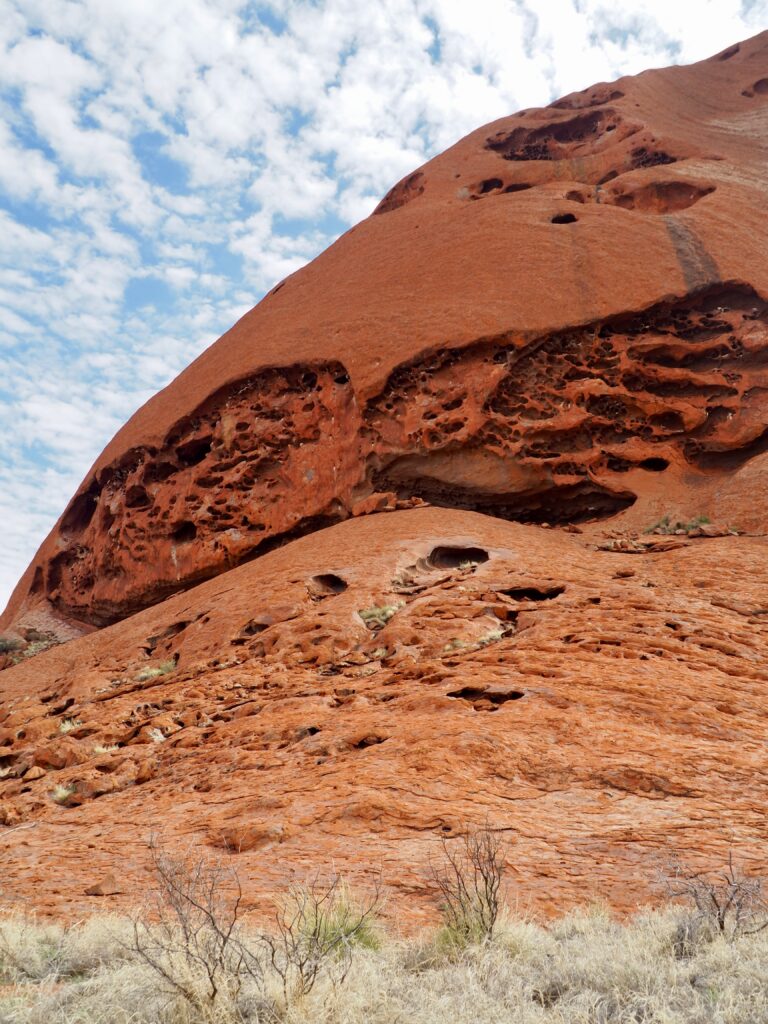
Karrke Aboriginal Cultural Experience
We bid Uluru farewell after that and drove onwards to the next destination of our week in Australia’s Red Centre, Kings Canyon. The road through the Red Centre is a pretty straight highway, with that flat desert landscape stretching out to the horizon on either side. We made a few rest stops at the stations along the way – literally the only places for miles and miles! And we did a little picnic lunch in a desert oak grove. Arriving at Kings Canyon Station, where we were staying in permanent tents on-site, we first stopped to see the camels! They have a whole herd of them with hay bales nearby so you can wander over and feed them.
Once we’d checked in, we popped across the road for our afternoon activity, the Karrke Aboriginal Cultural Experience. Run by a brother and sister duo, they led us on a fascinating exploration of desert Aboriginal culture. It’s worth remembering that Australia is so vast, its Indigenous people have variations in culture, customs and language across the country. So what the desert people out here do may be different to say, the coastal peoples by the ocean.
They taught us about bush medicines and bush tucker using the local vegetation and wildlife – yes, including witchetty grubs! No, we didn’t eat them though. We got to handle spears and boomerangs, all different shapes and sizes. And they explained the practice of dot painting and beaded jewellery making which are actually more recent customs. It was really great to learn all of this first-hand from Aboriginal people, who learned it from their Elders, knowledge passed down for generations. And it still amazes me how they learned to survive out here in the desert!
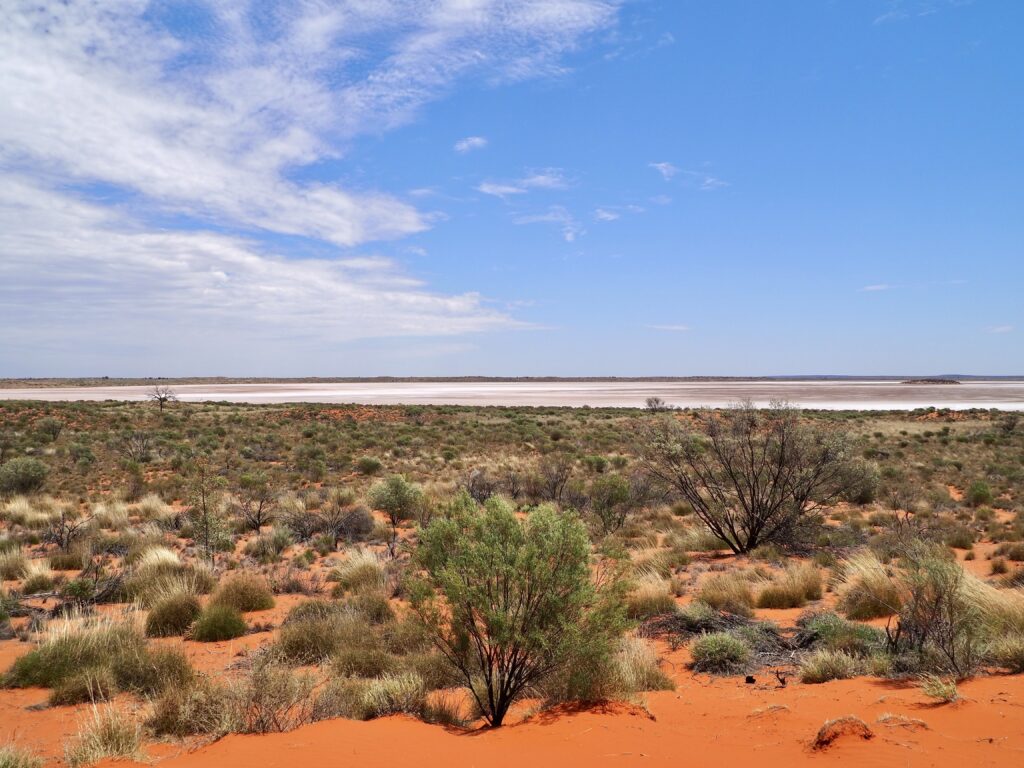
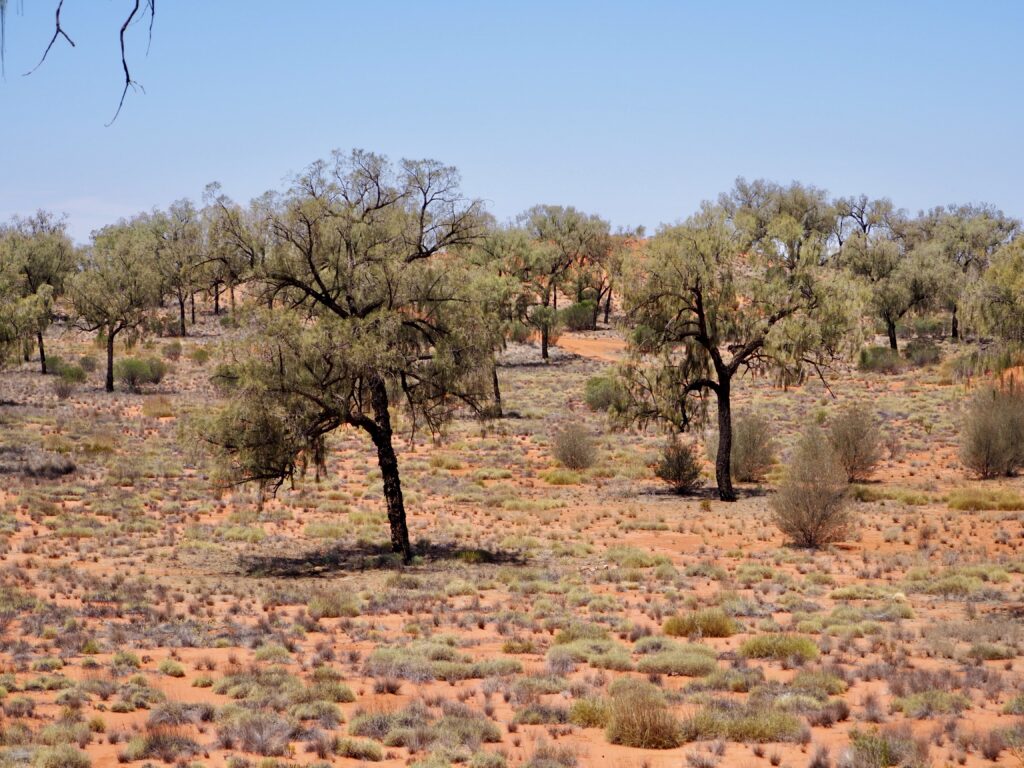
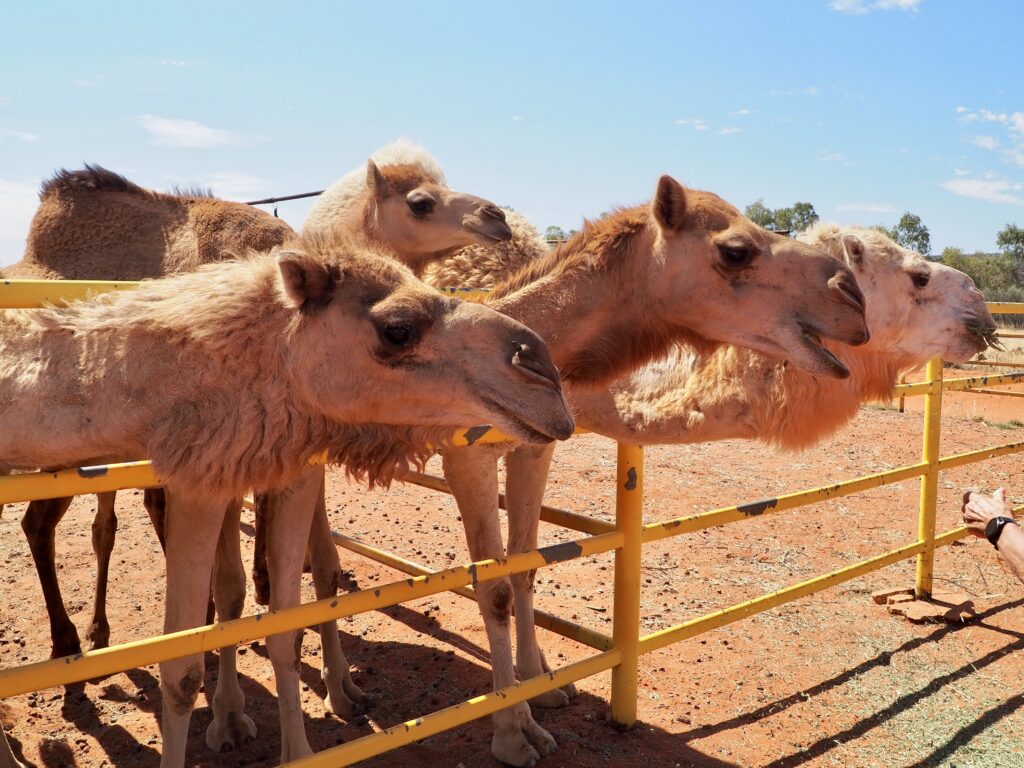
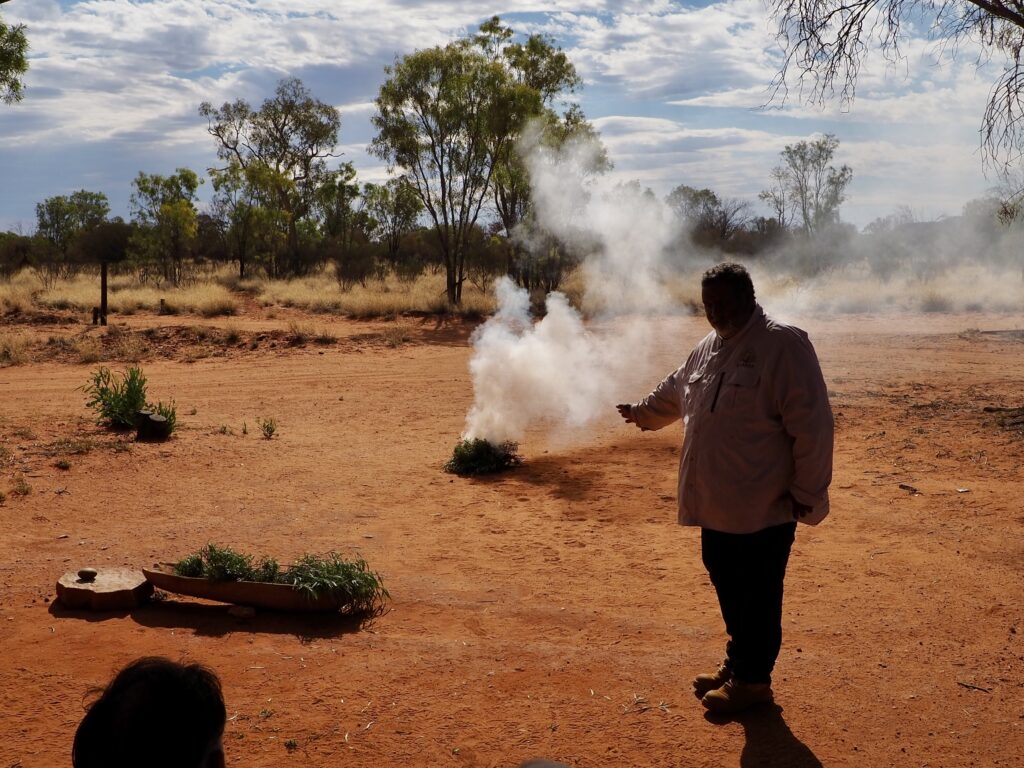
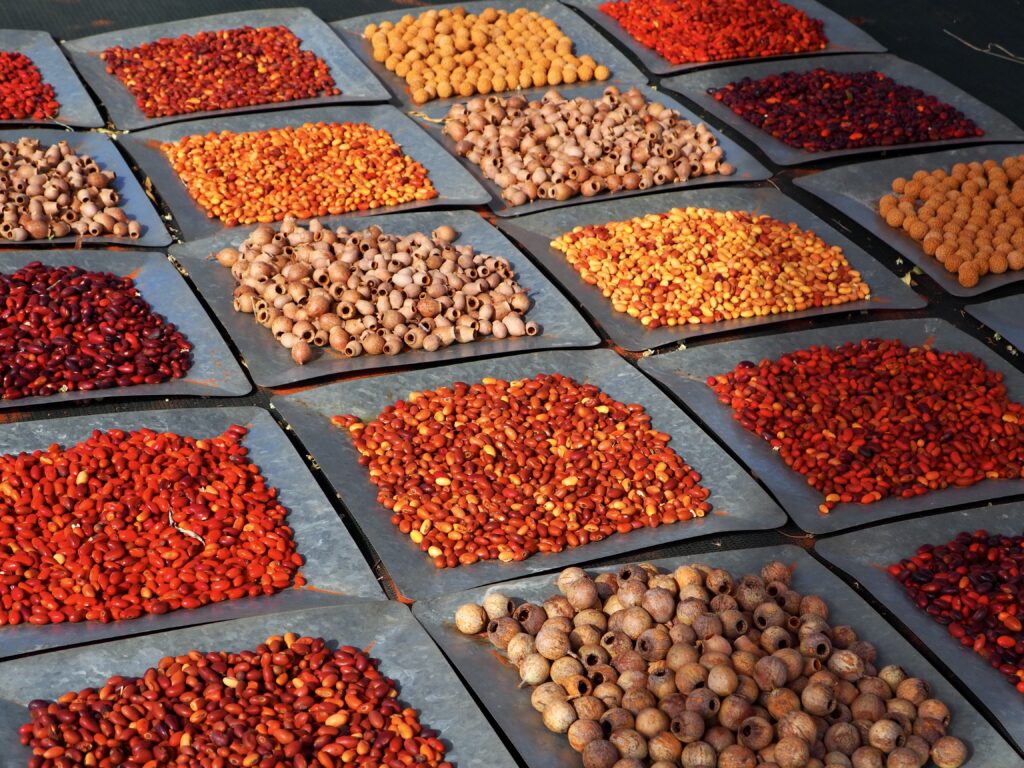
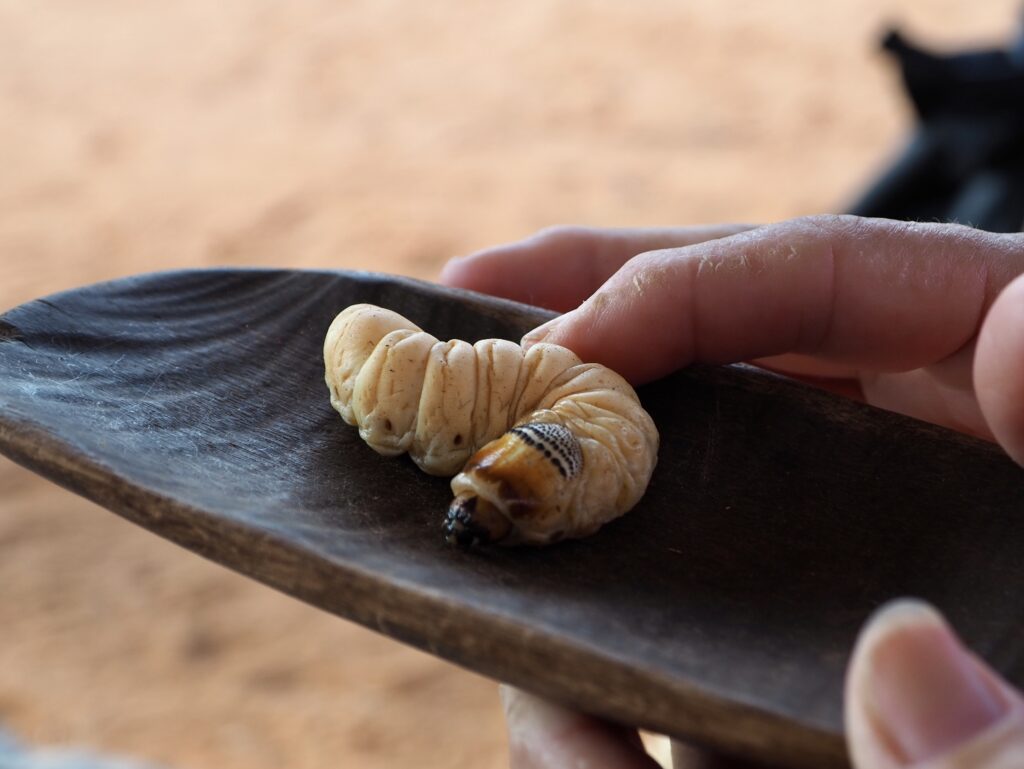
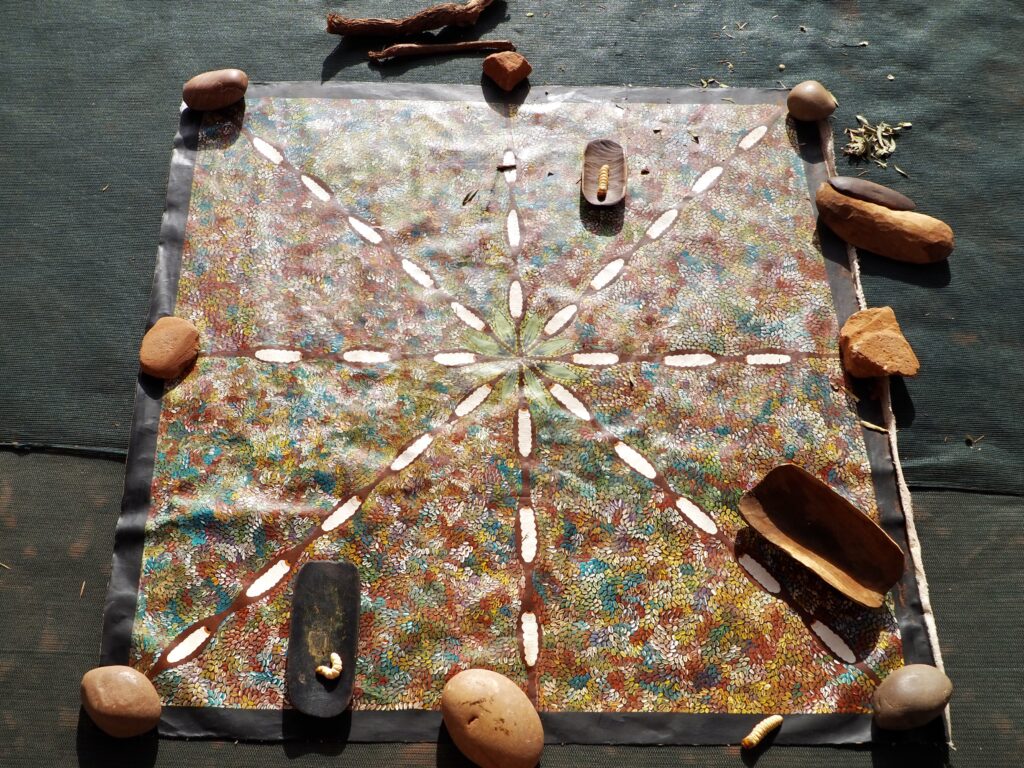
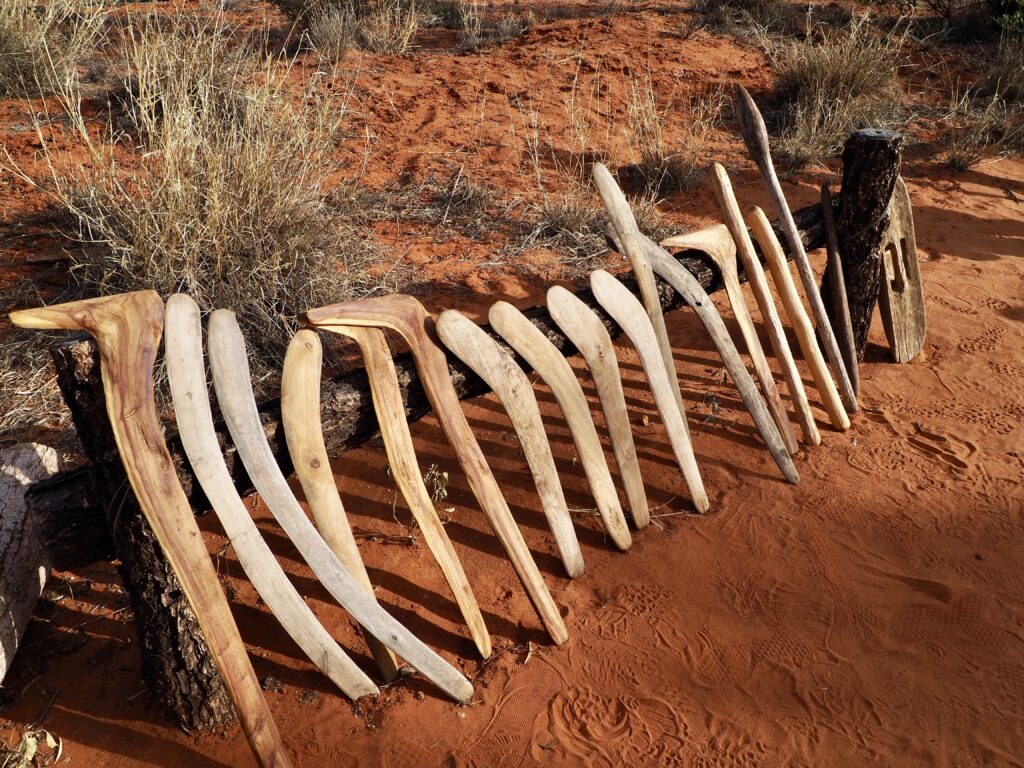
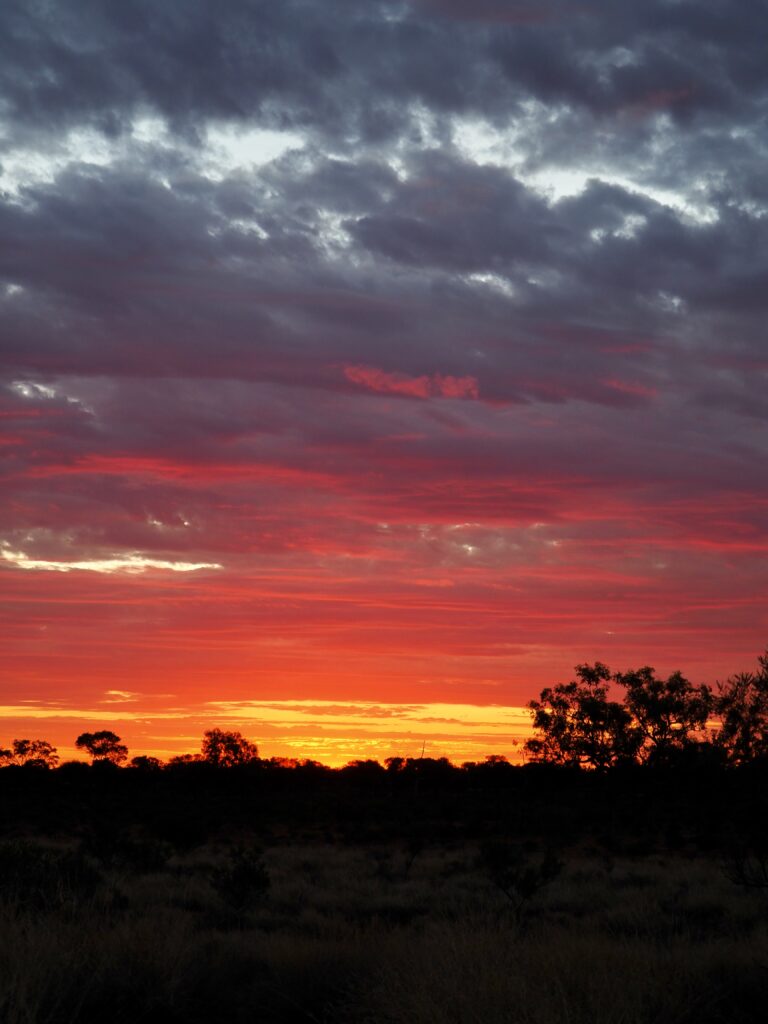
Day Four – Kings Canyon
We started the day in Kings Canyon, with an early morning wake-up to head out on our half-day hike in Watarrka National Park. The Kings Canyon Rim Walk takes around 2-3 hours and we began before sunrise to beat the heat. The hottest part of the day was spent on the road, driving across the Red Centre to Alice Springs. We’d be spending 2 nights here, and much of the group had also stayed a night there prior to the trip starting, as there are more flight connections available. It’s not the most exciting town, and has gained a bit of a reputation for crime in recent years, but is a necessary stay for most Red Centre trips.
Kings Canyon Rim Walk
The Kings Canyon Rim Walk was an immediate contrast to the flat landscape around Uluru. We first scaled a steep incline to the top of the canyon. The route took us through a rocky landscape, with huge boulders, narrow passes to squeeze through and ancient striations carved underfoot. And of course, the deep gorge of the canyon in the centre. The trail alternated views of the drop with sections further from the edge filled with boulder-strewn scenery.
Halfway through, it was time to cross the canyon. This is done via a series of wooden staircases and boardwalks. The actual crossing is a fairly short bridge, and not all that high up! We also took a detour here to the “Garden of Eden”. Down inside the canyon hides a large watering hole and an abundance of plant life. While the rocky landscape is largely hues of yellow and orange, the canyon interior is a riot of greenery. Hence the name, a hidden paradise within the harsh desert!
On the other side of the rim, the green theme continued as we got an incredible view into the canyon. The way the rock overhangs, you can see far deeper from this side. And we could see the massive, sheer slab of orange and black striped rock we’d just been walking on! The path downhill was also surrounded by more desert scrub and wildflowers blooming. Throughout the hike, we’d taken plenty of breaks, partly to stick together. But also to allow our guide to teach us about the flora and fauna of the Outback. It was a big, tiring walk but a highly enjoyable and educational one!
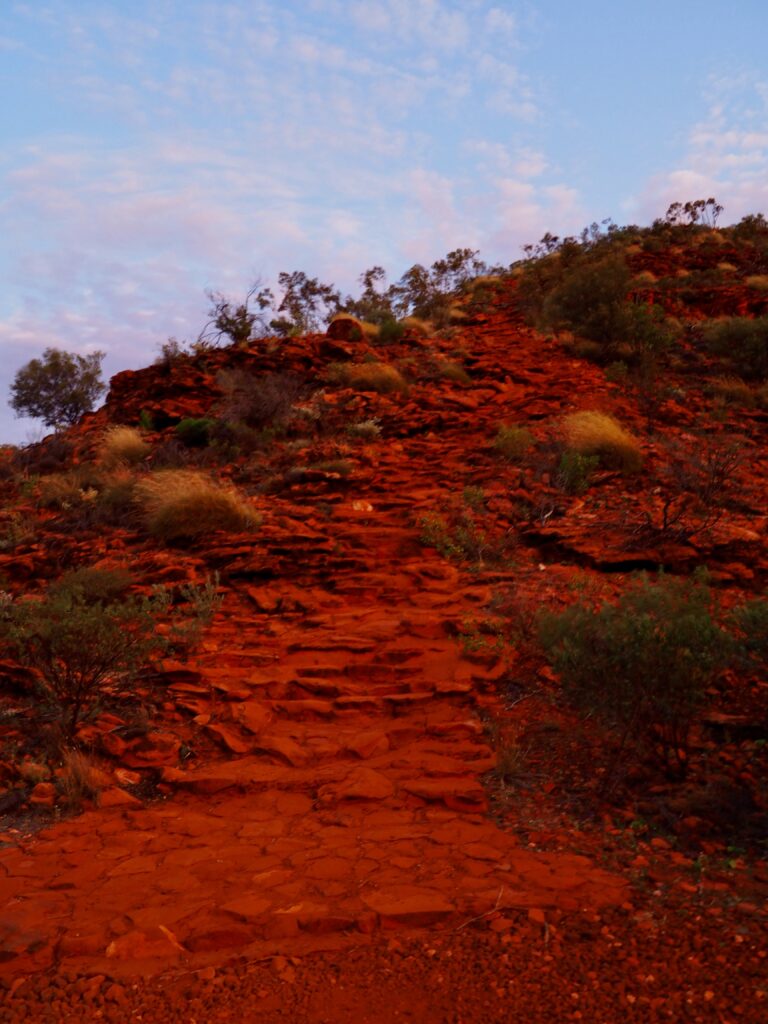
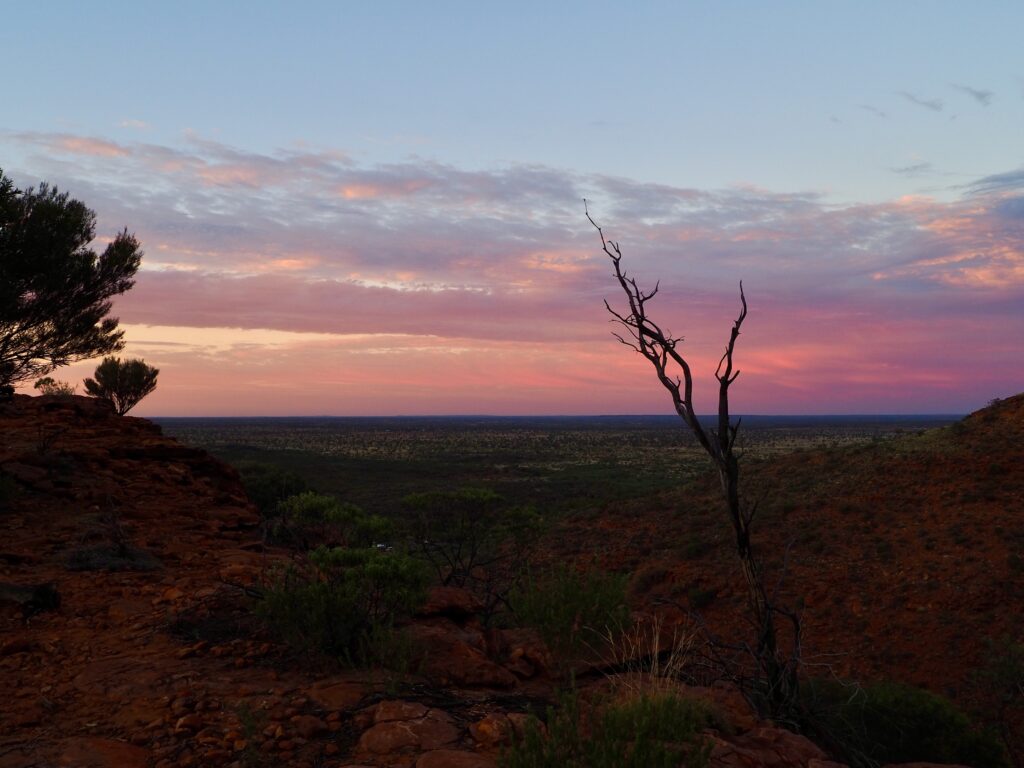
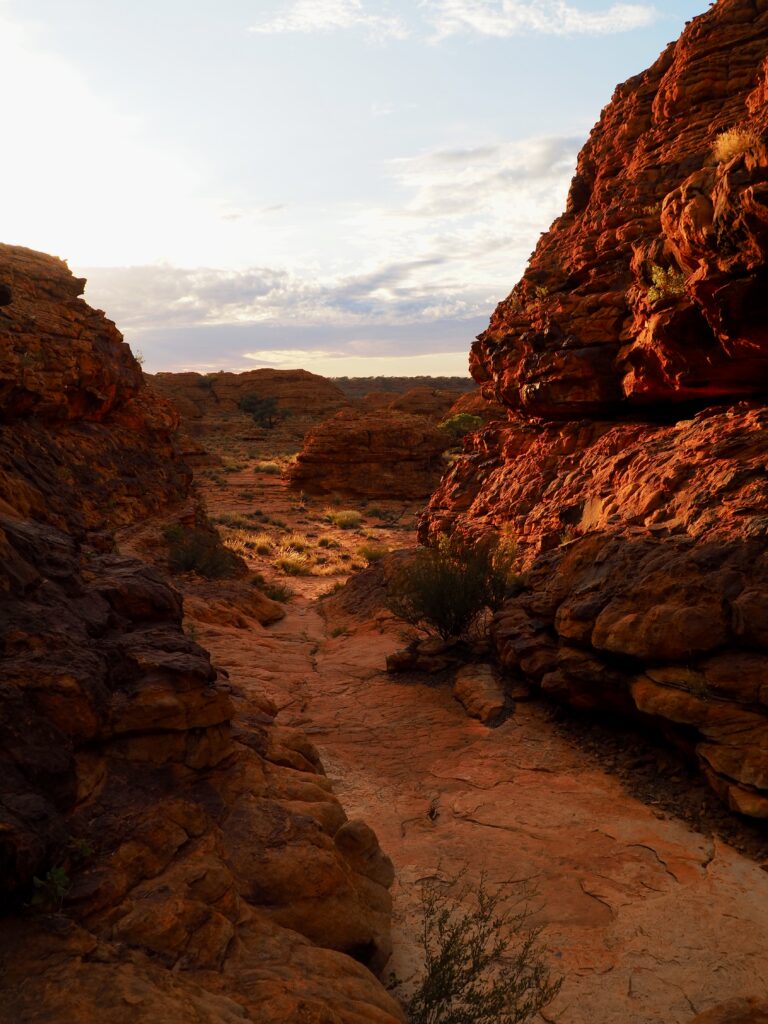
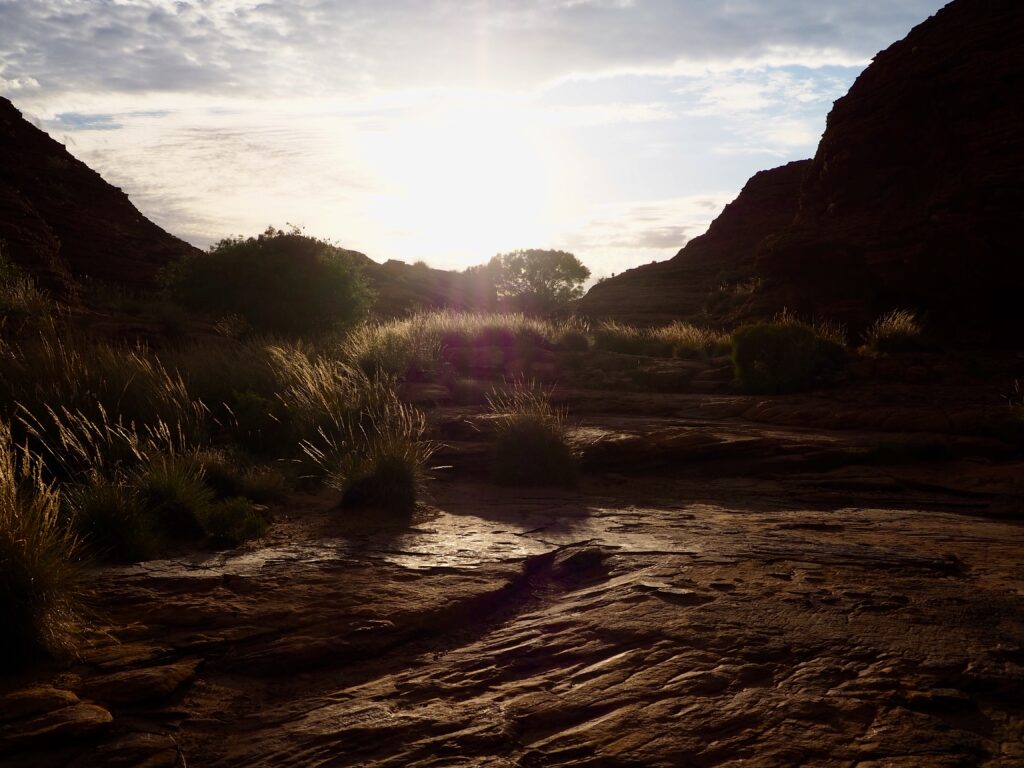
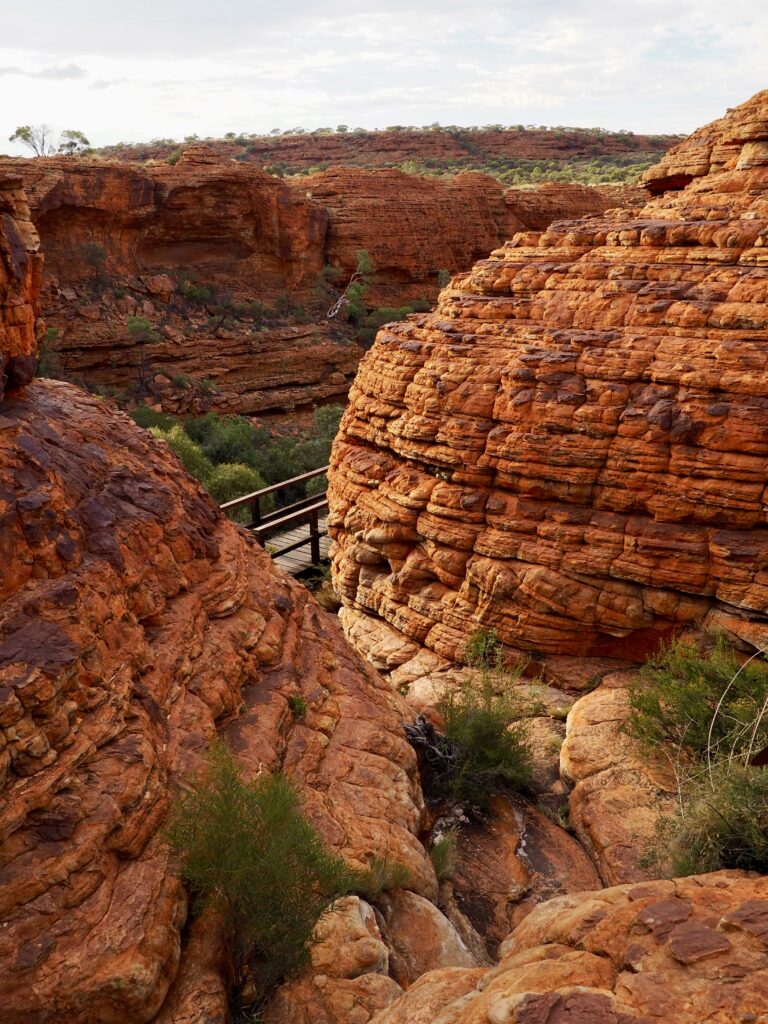
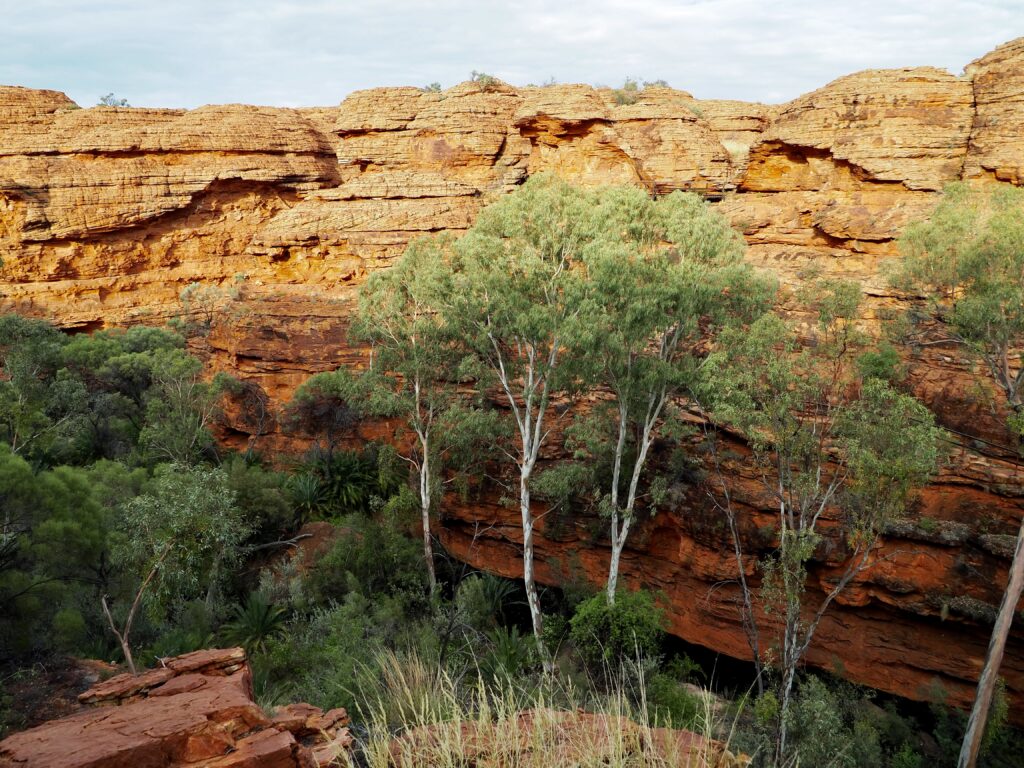
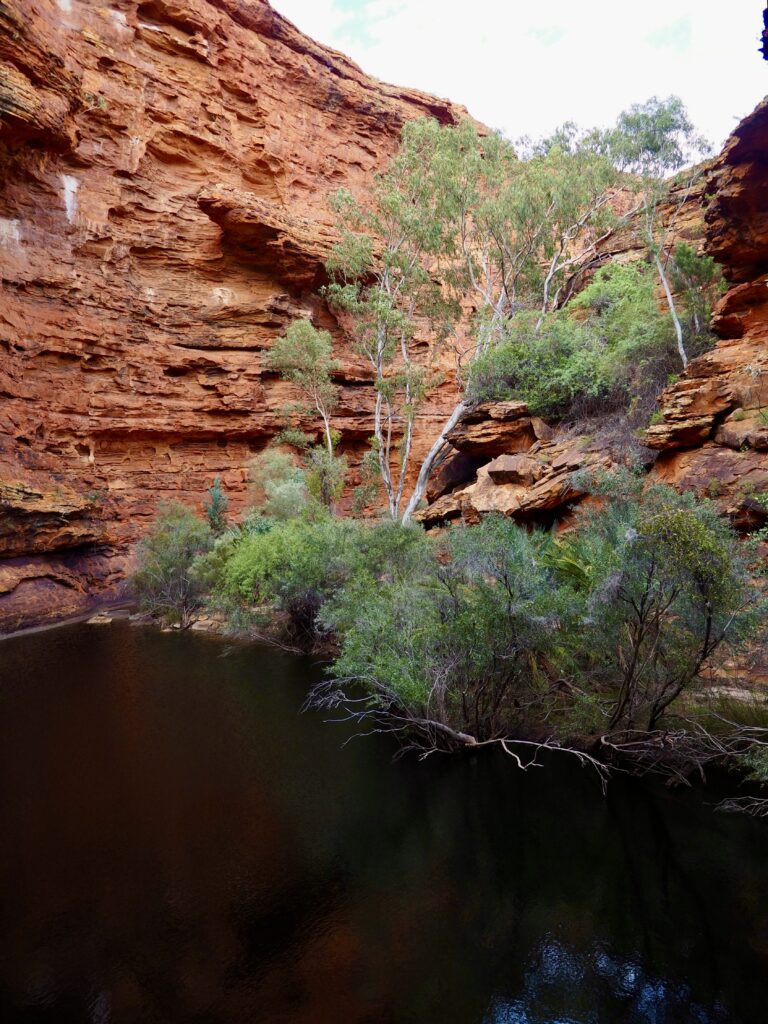
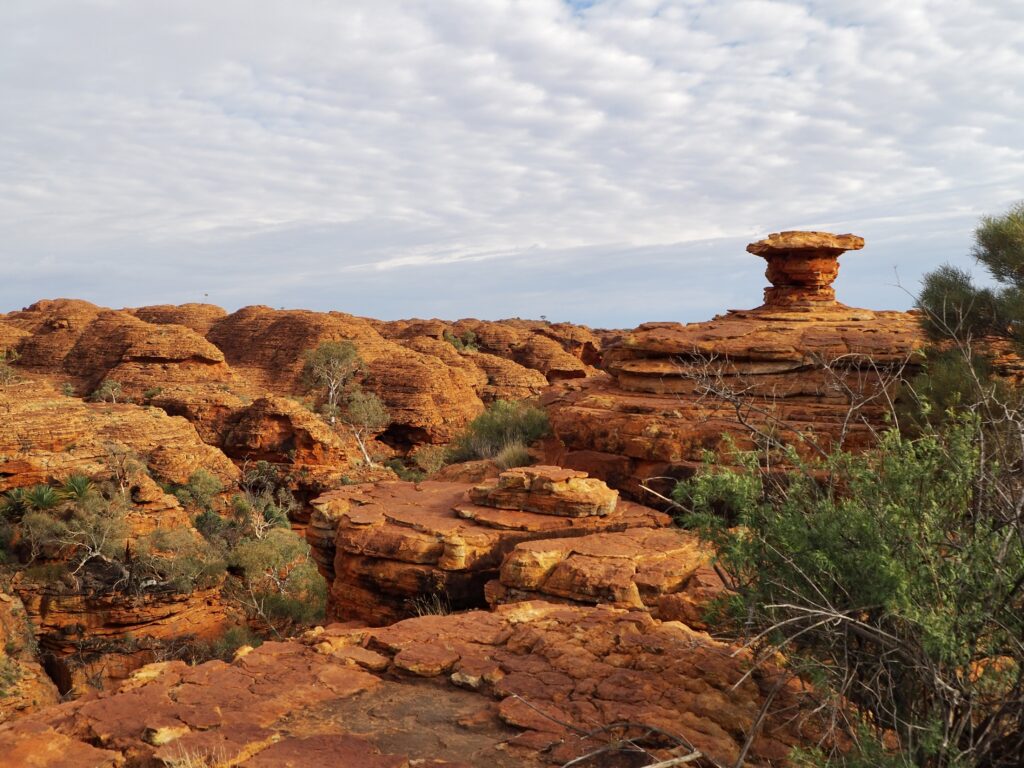
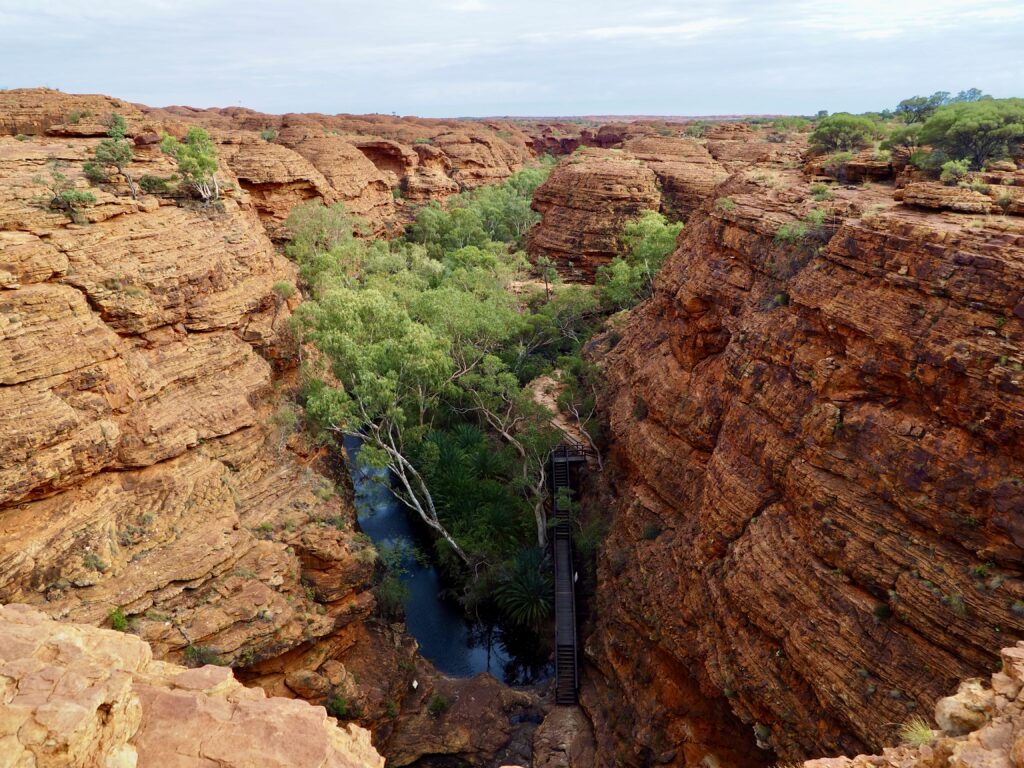
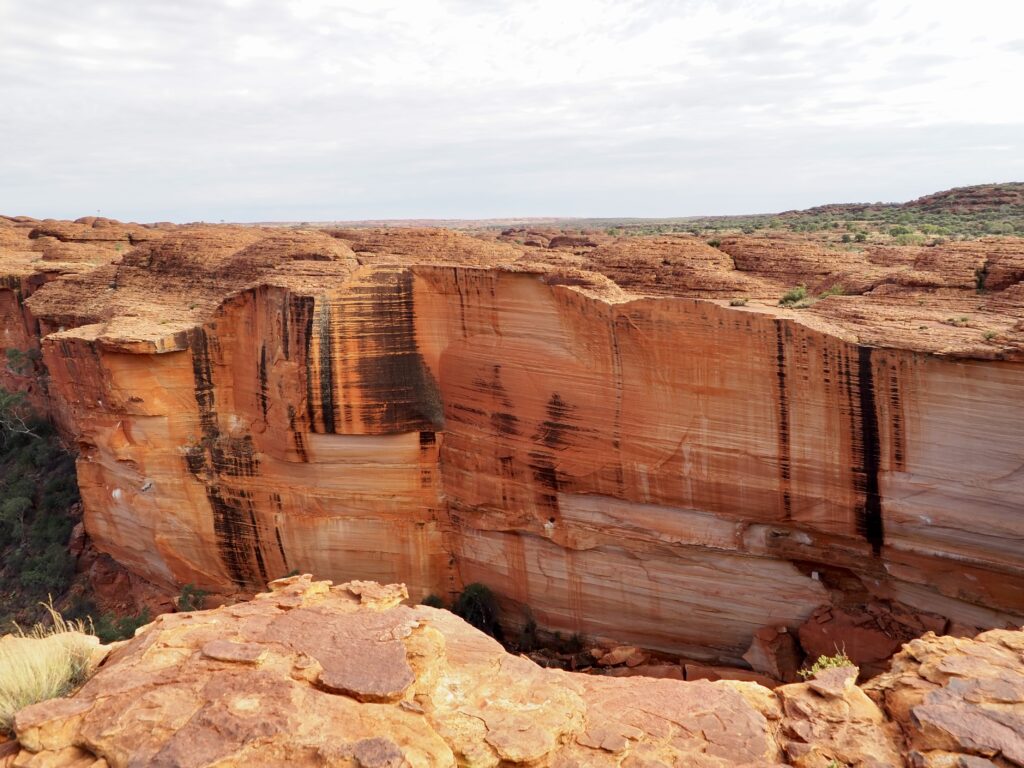
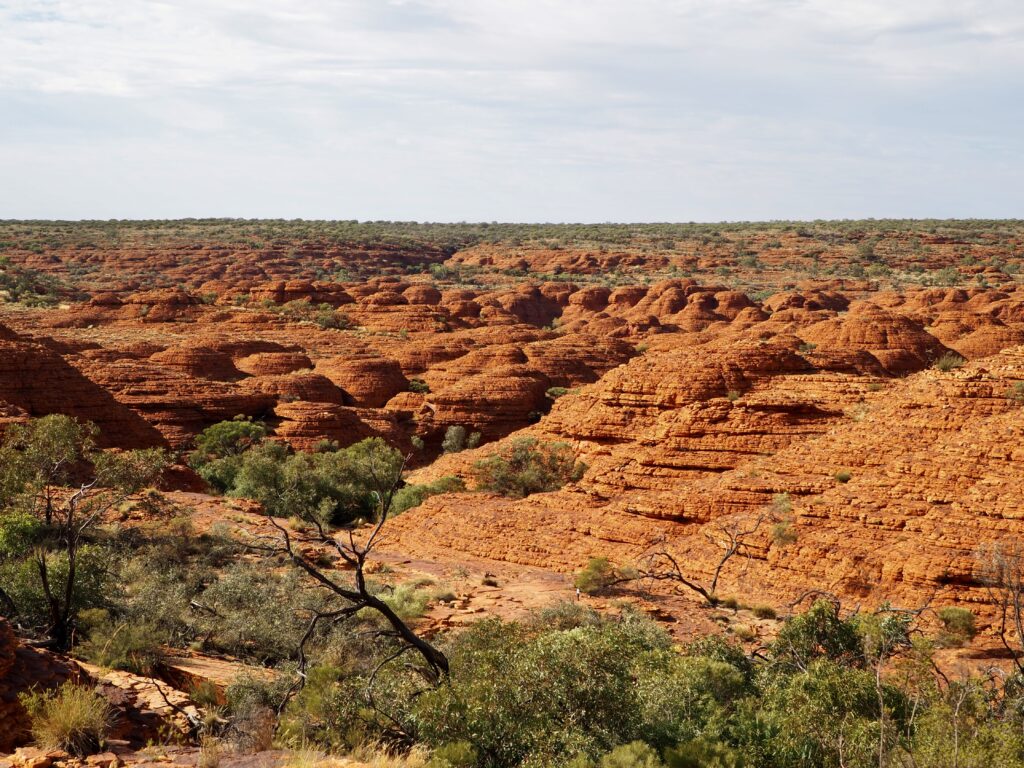
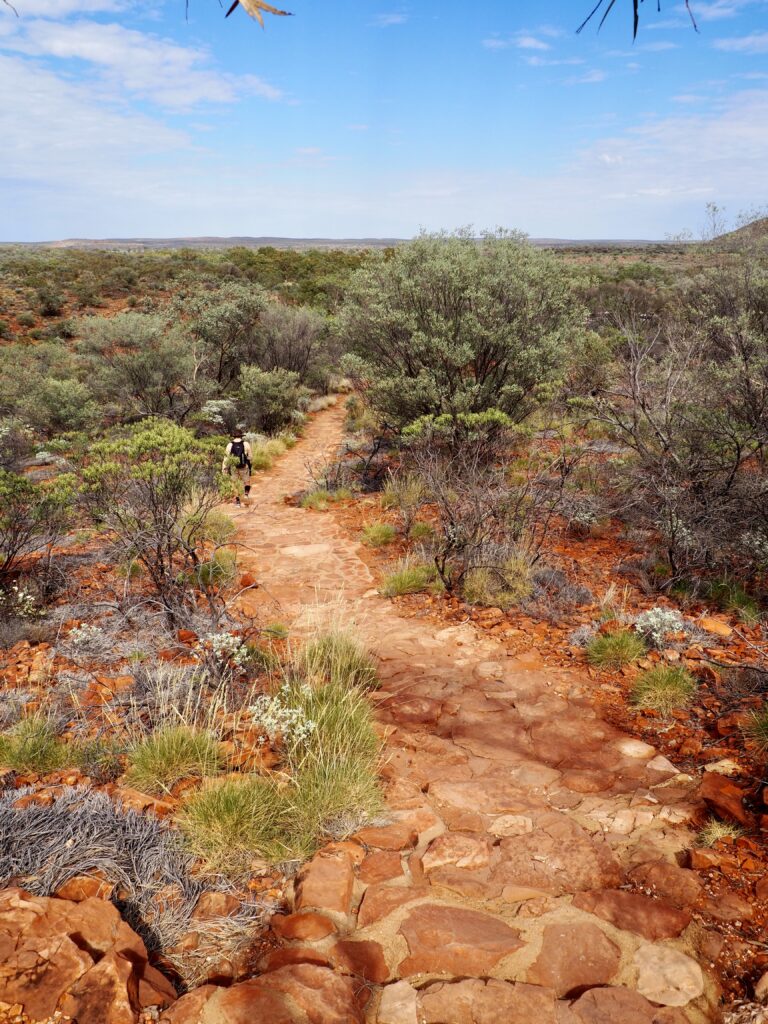
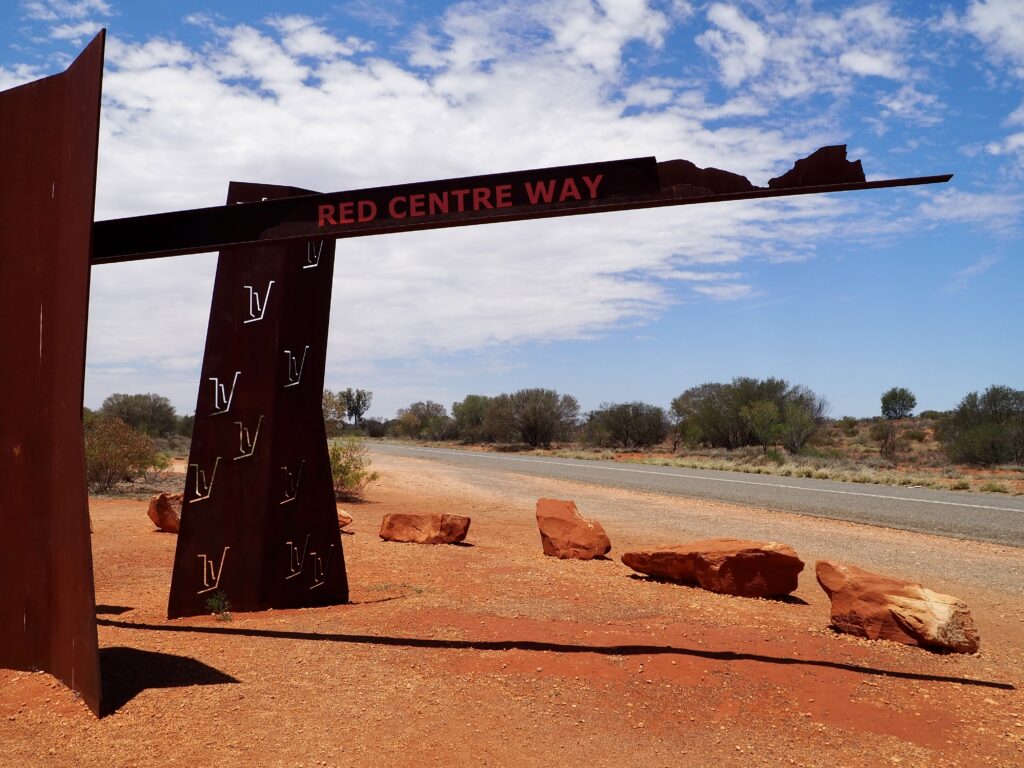
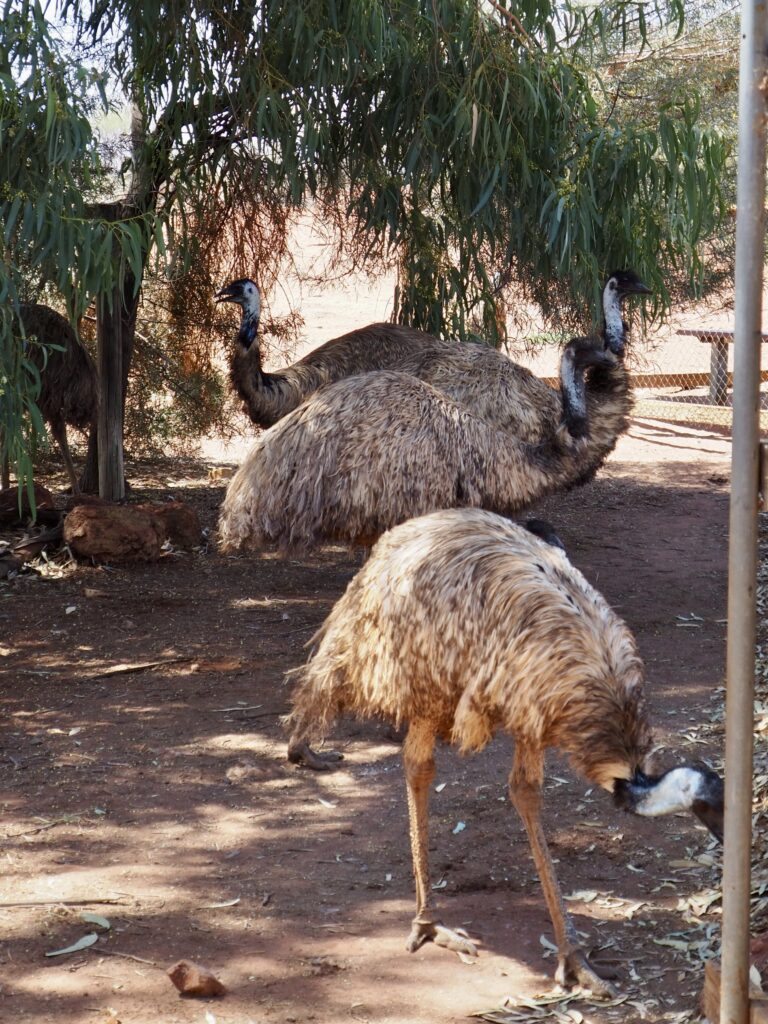
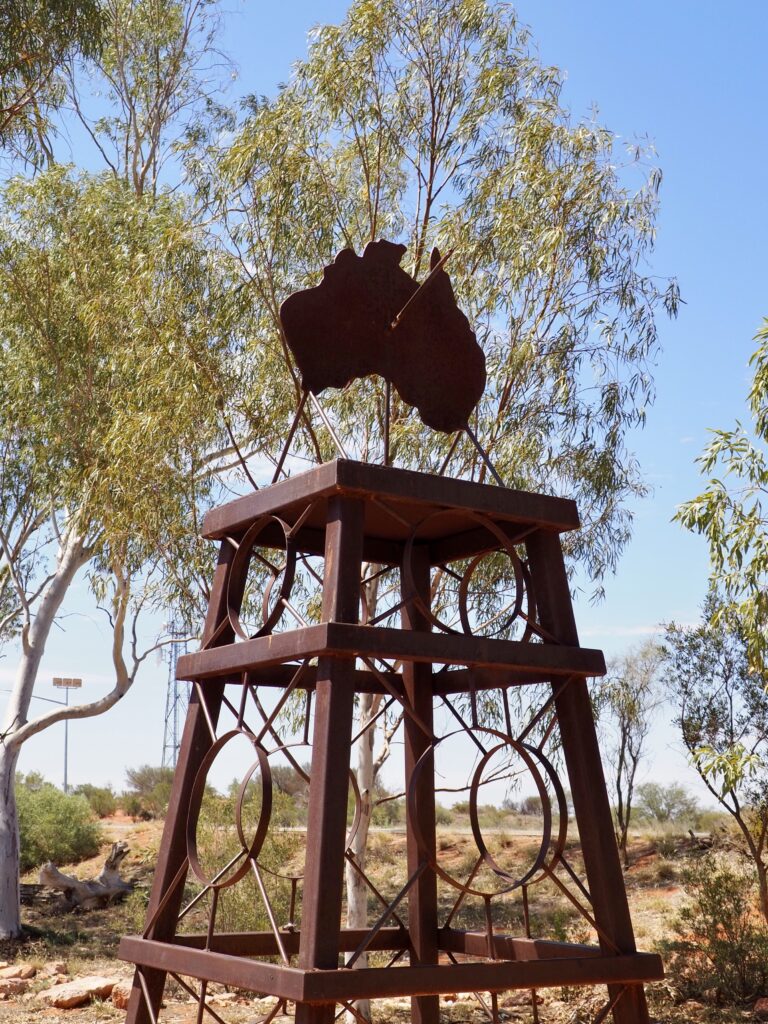
Day Five – West MacDonnell Ranges
Our guide picked us up in Alice Springs again this morning for the final day trip of our week in Australia’s Red Centre. Many tour itineraries are shorter than ours, and this is the day that most of them would skip. We were heading out of town to the West MacDonnell National Park, or Tjoritja, to use its Aboriginal name. The park is like a long spine of mountains, with rounded peaks like a caterpillar slithering through the land. It certainly looked like one from the viewpoint we stopped at on the way in! While we did come across a few other visitors throughout the day, this was definitely the least busy of all the destinations on our trip.
We kicked off with yet another big hike! Although, we all agreed that we should have started this one earlier in the day than we did. The Ormiston Gorge Pound Walk takes around 4 hours and that was with far fewer breaks than we had in Kings Canyon! It was after midday when we finished, and inside the gorge there is very little wind, so it was very hot. Make sure you carry plenty of water as there’s nowhere to refill! However, it is a gorgeous walk!
Ormiston Gorge Pound Walk
The first portion had us gradually ascending the hills, the most lush and green of the trip so far! Mountainous views unfolded around us, again so different to previous landscapes. As we approached the pass that leads into the pound, we detoured to a viewpoint first. The hills dropped away to reveal a massive valley below, stretched wide across the land. Our guide had kept fairly secretive about what to expect on this hike, and for good reason – we were all completely awestruck by this view!
Descending into that valley, we crossed its flat floor, weaving through desert trees. A river carves through the middle, where we stopped for a break in the shade of some trees. The trail led us towards the gorge, where the river bed squeezes through the vast hills on either side. Most of the water has actually sunk underground, so we were hiking over the massive purple (and very pretty!) riverbed stones. It was a little tricky going at times although I’d take the boulders over the sand later on! A few water holes emerged again further through the gorge.
Then we had one final ascent to a lookout point with a lone tree on the cliff face. Here we were met with a view back down over the gorge we’d just climbed out of. Then one last staircase in the cliff to take us back to the car park. I know many of the group were struggling with the heat by then. I actually fared ok with it, I was just tired. But I loved how different this landscape was compared to the others we’d seen. And even so varied throughout the walk, from the hillsides to the pound to the gorge itself!
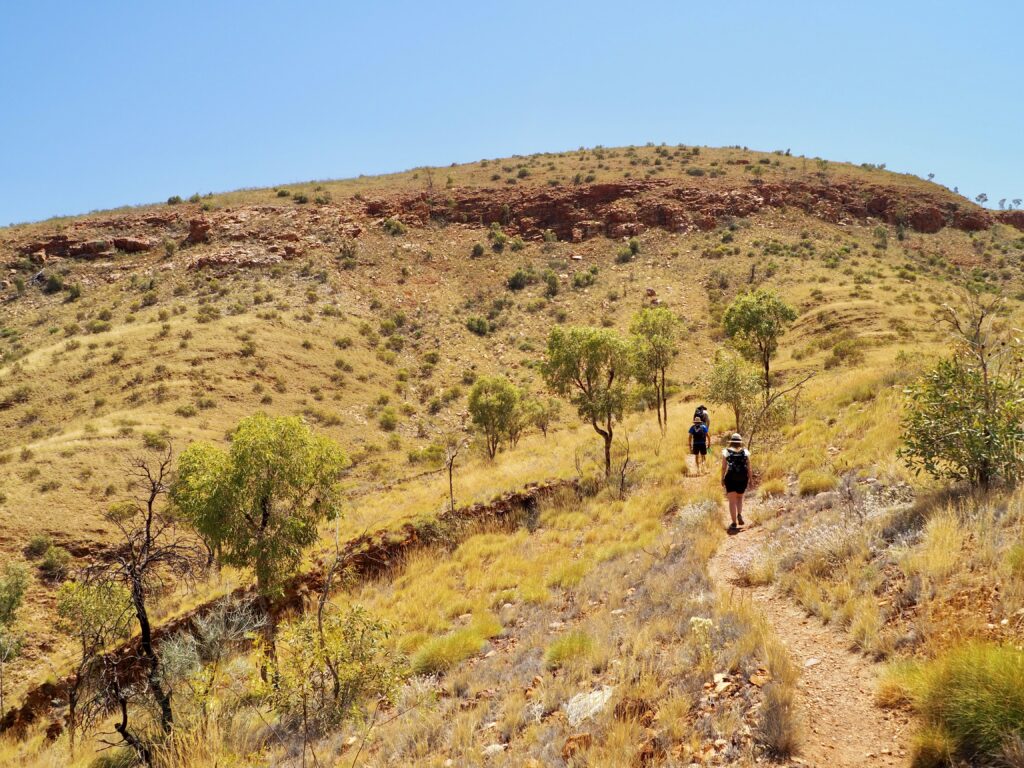
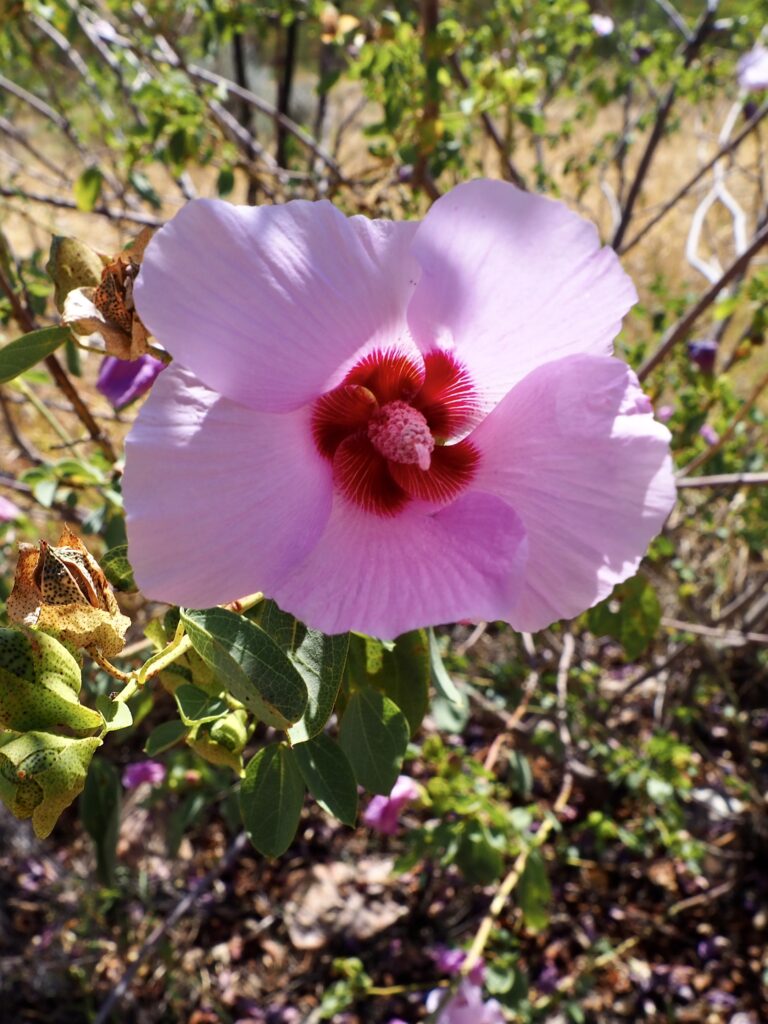
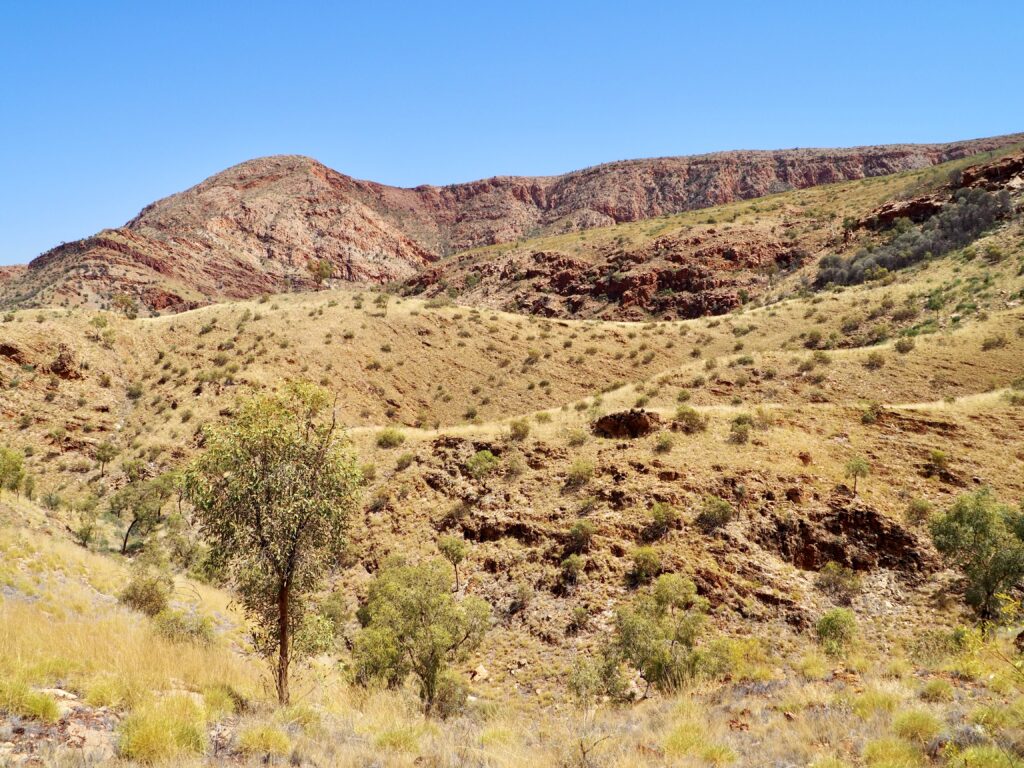
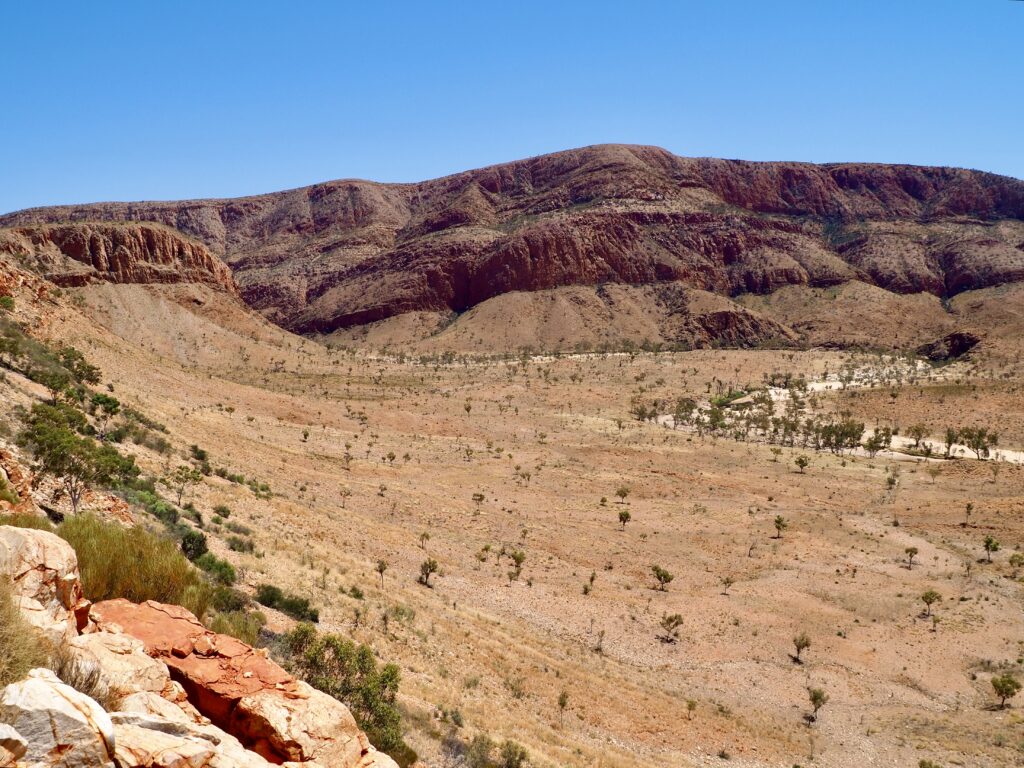
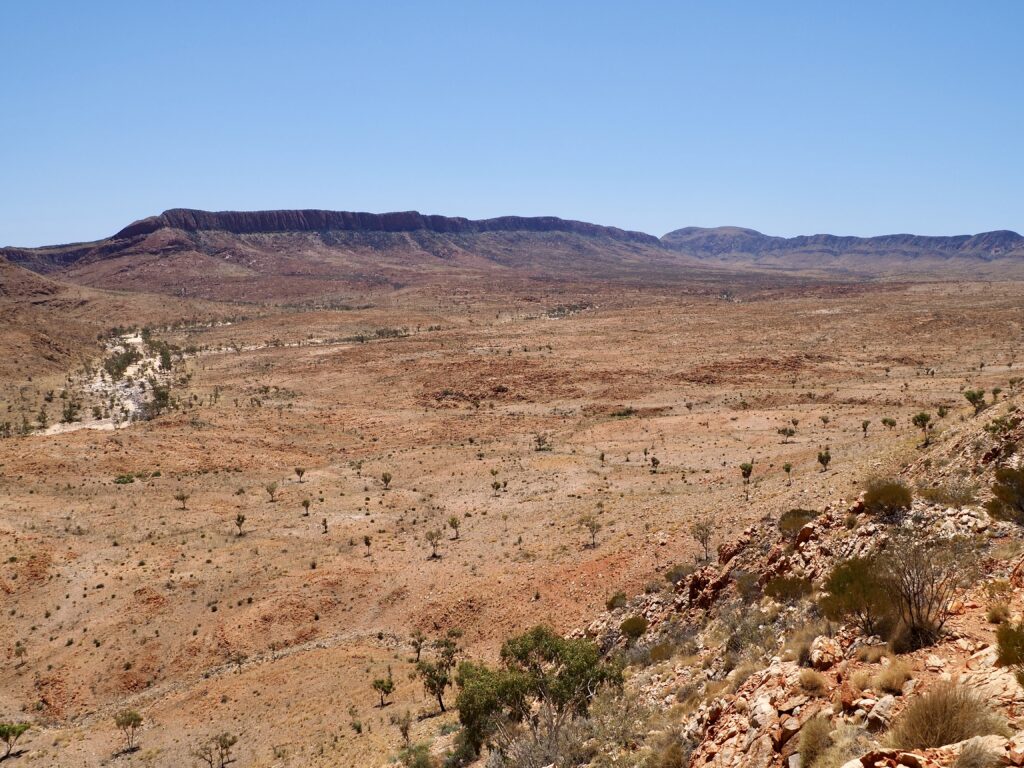
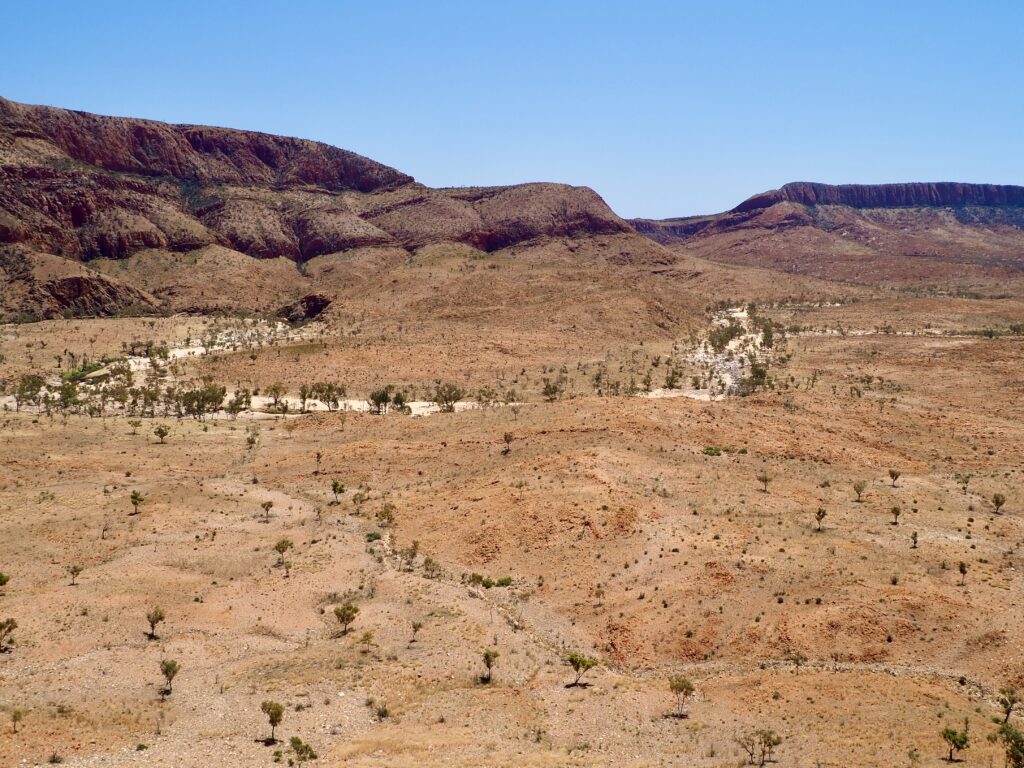
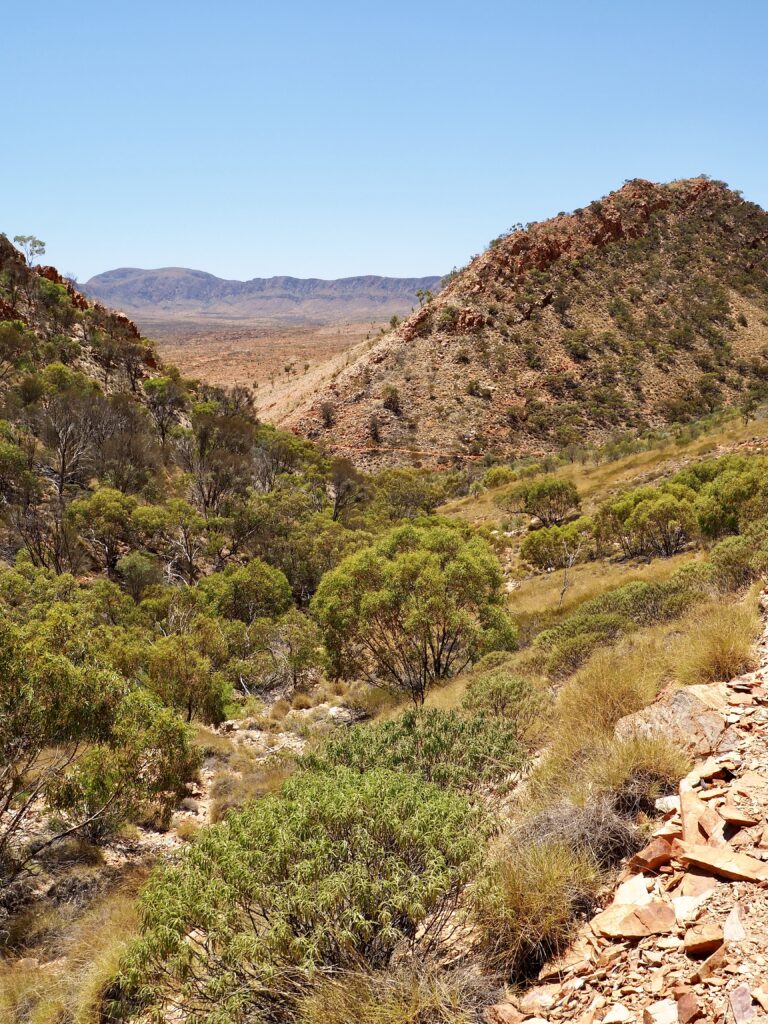
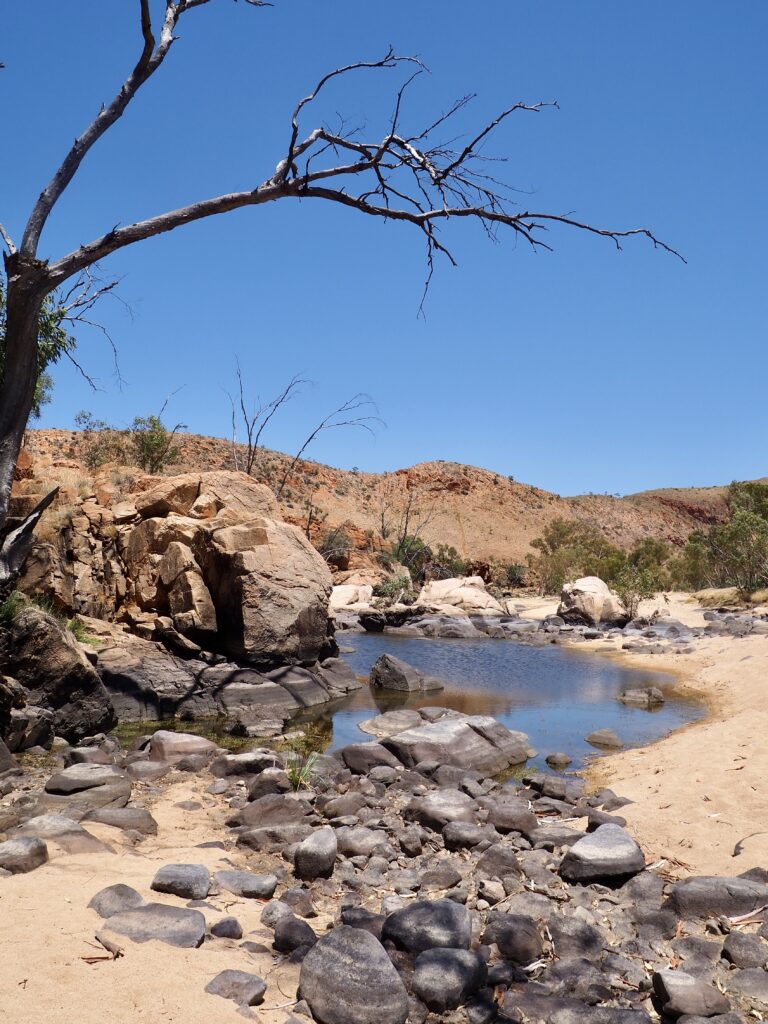
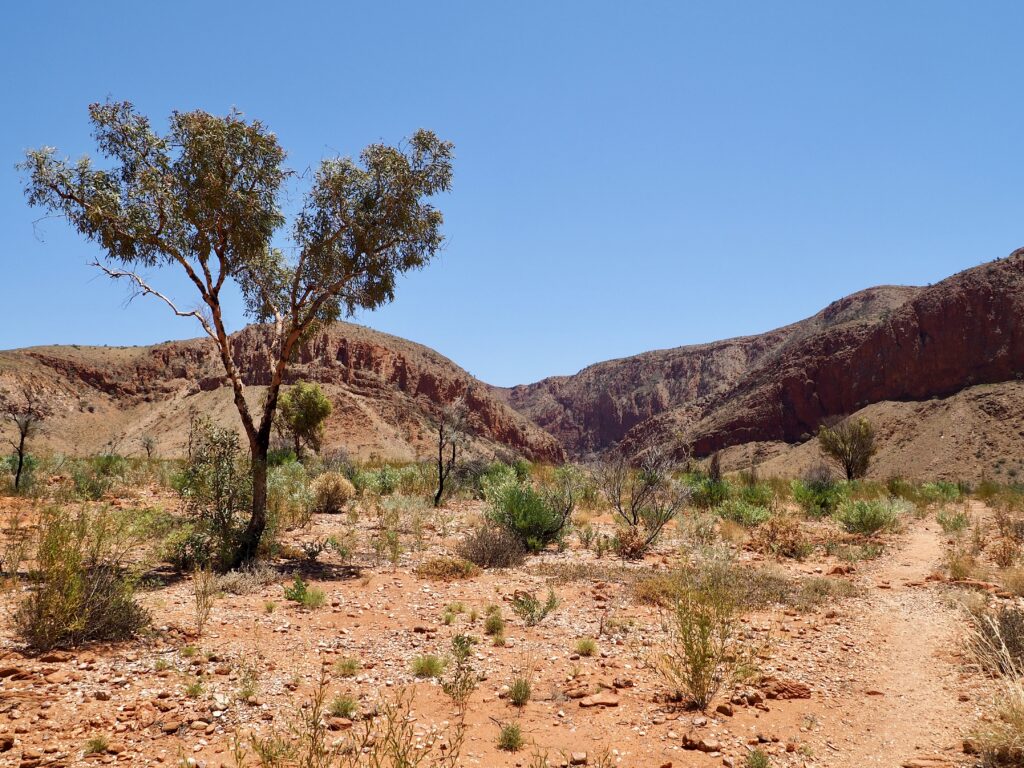
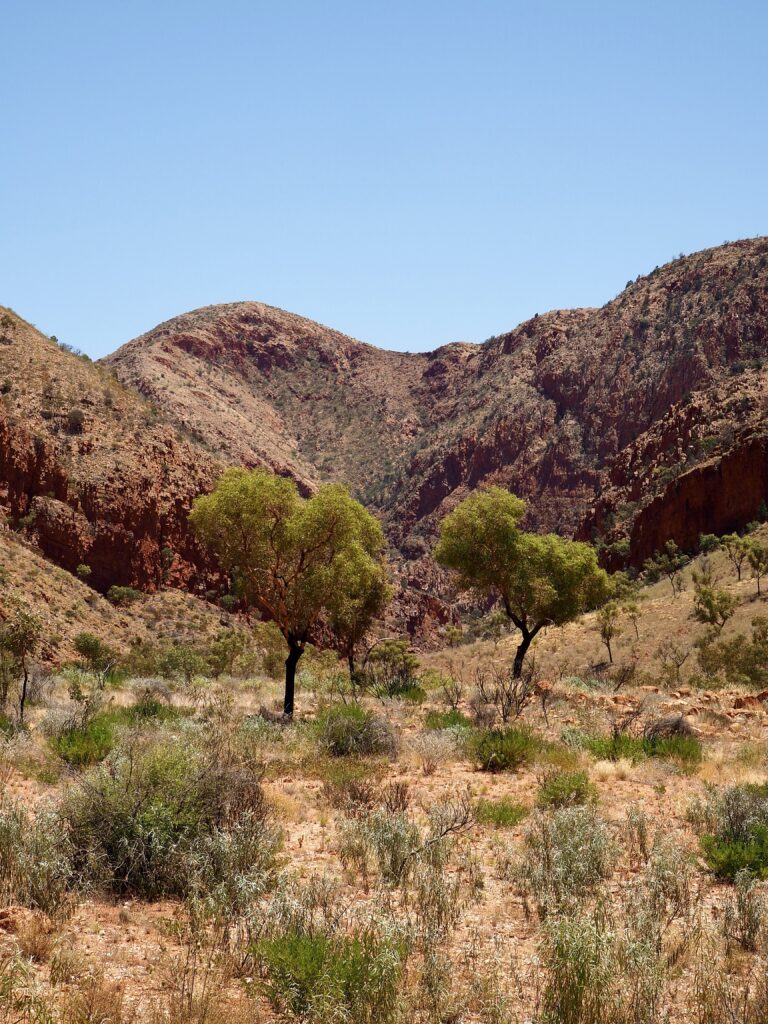
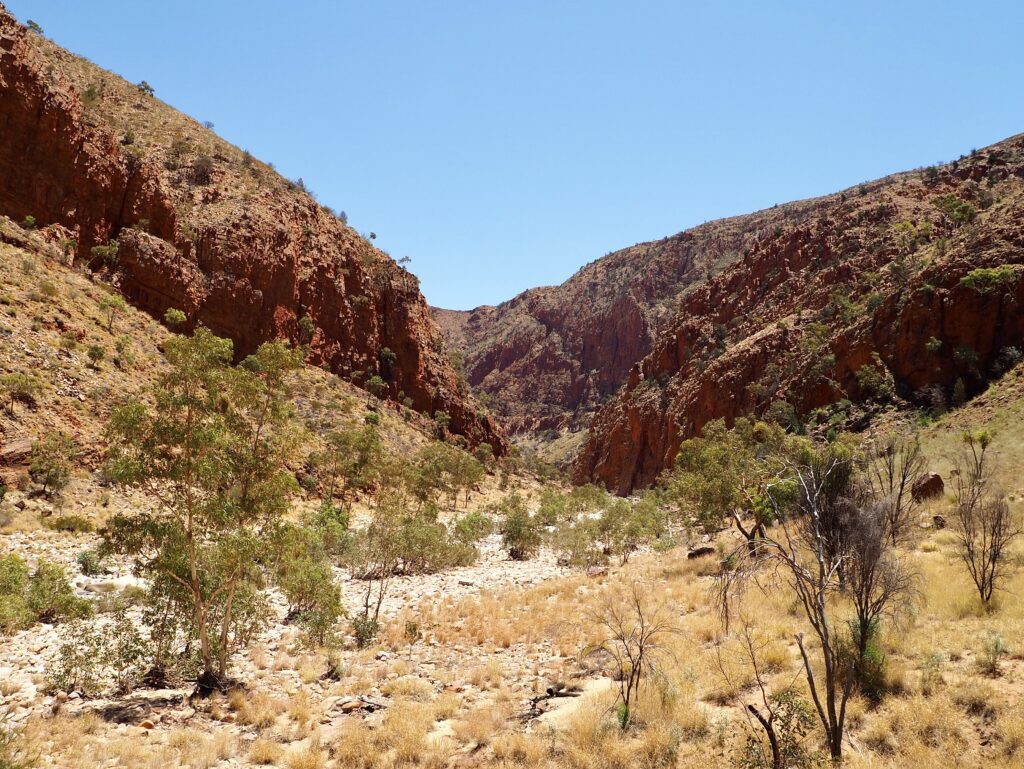
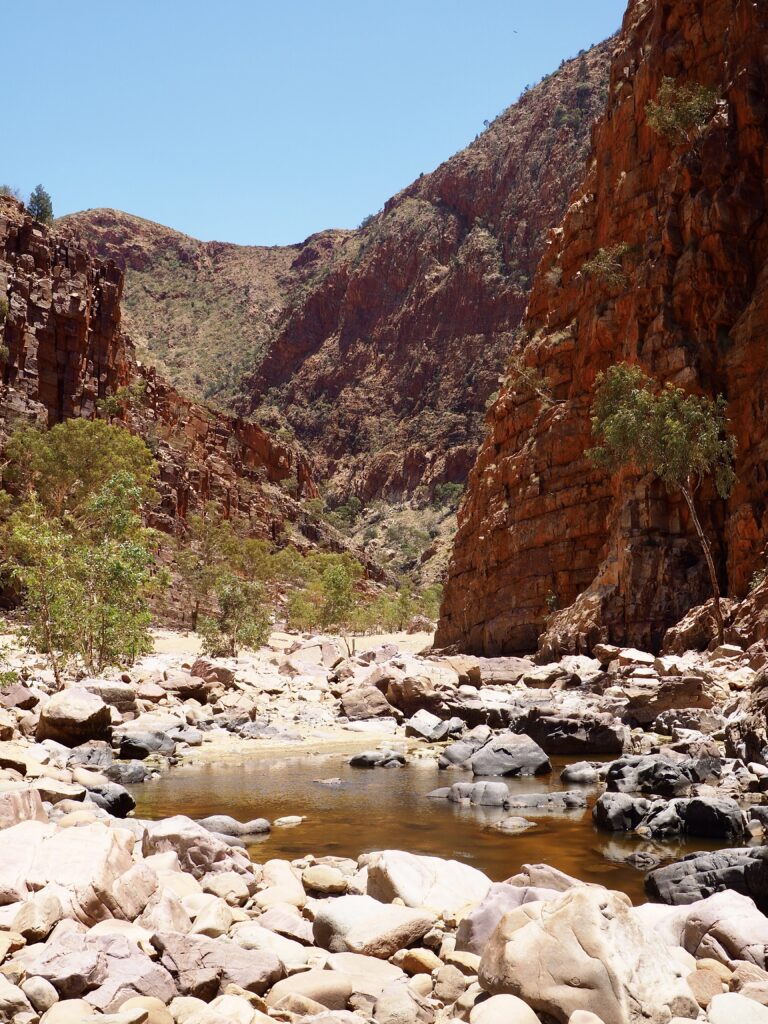
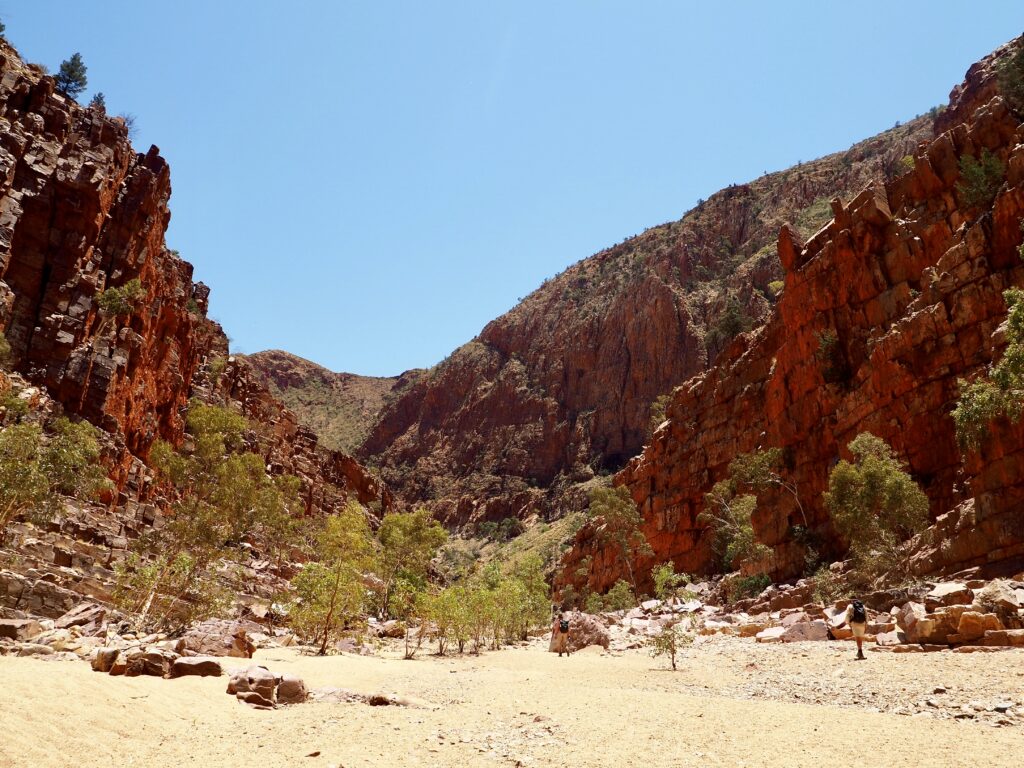
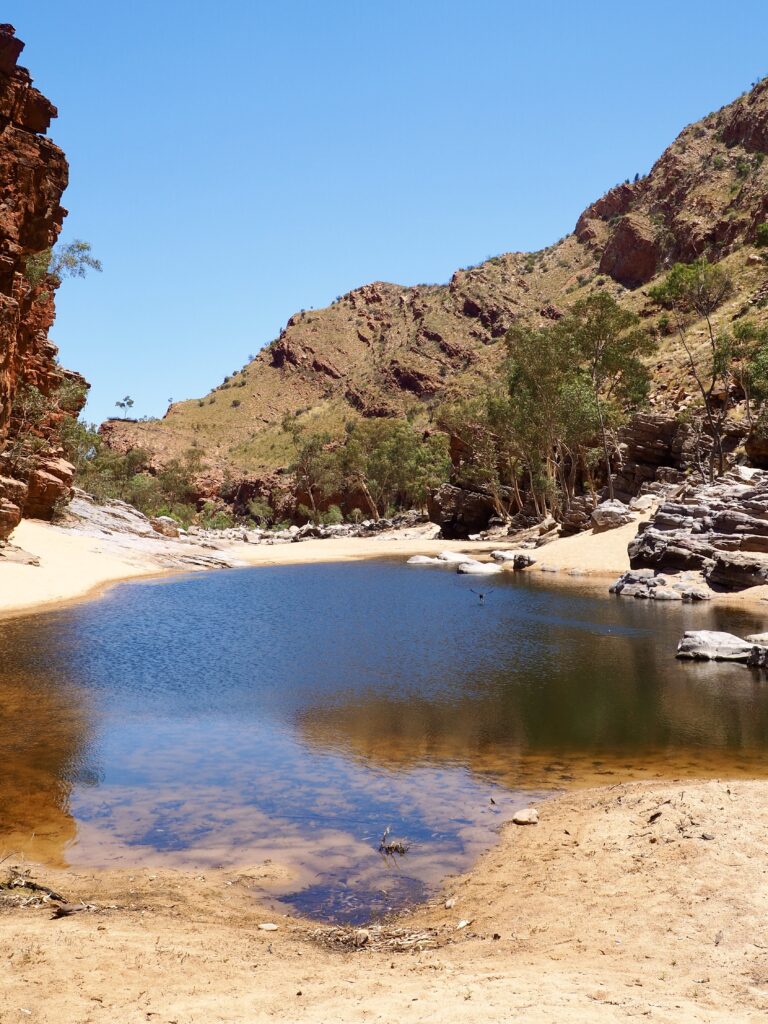
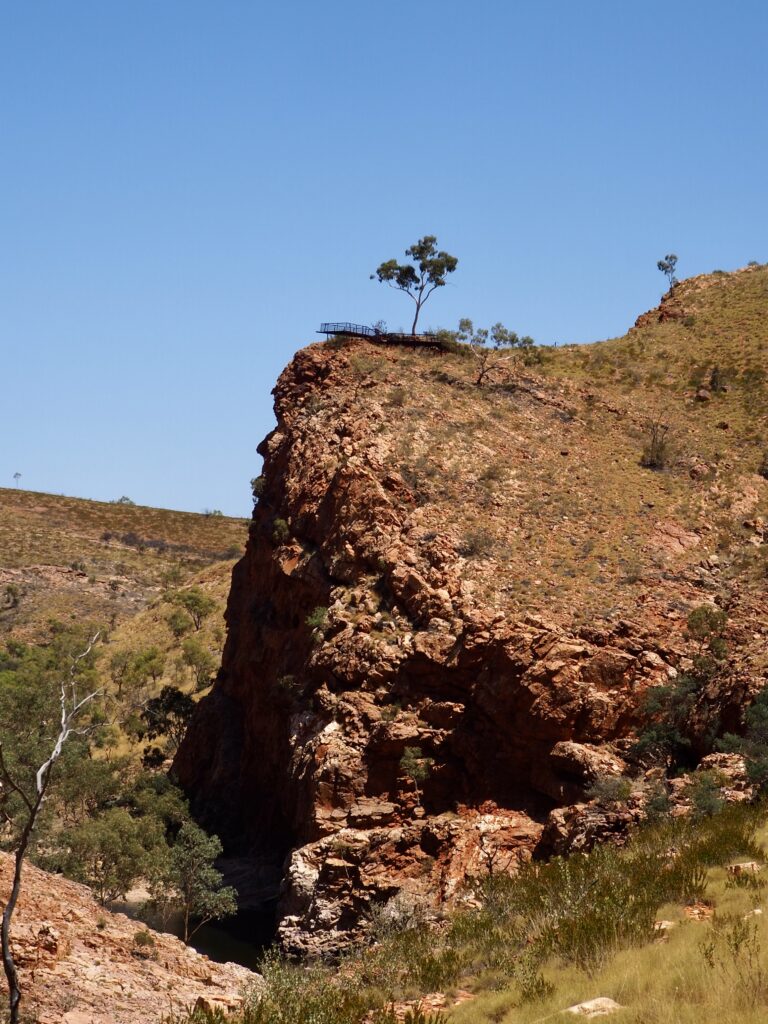

Ellery Creek & Simpsons Gap
After lunch, we had a slightly more relaxing afternoon at a couple more scenic spots in the West MacDonnell Range. First up was Ellery Creek, a swimming hole to cool off from the afternoon sun! The water is cold and deep, so you need to be a fairly strong swimmer once you’re out of your depth. But you can also just lounge and paddle in the shallows! Steep rock faces surround the creek, making for a pretty view. A few of our group swam all the way out between them, but after this morning’s hike and with the water being so deep, I got tired before I made it that far! It was definitely still a scenic spot to relax for a while.
Then we headed to Simpsons Gap, another narrow opening with steep rock walls on either side! This one also has water, but a shallow stream, so not for swimming. The sun was getting low by this time of day now, so the steep walls cast the canyon in shade. The gap probably wasn’t the most spectacular scenery of the trip, but it was pretty and peaceful to just sit on the sandy ground for a while. The highlight was spotting rock wallabies! The sides of the gap have large rockfall piles, which is the ideal habitat for this small species of wallaby. You have to watch carefully for movement, as they’re so small and similarly-coloured to the rock that they blend right in. But we managed to find a few and watched them hop their way around the boulders before we left.
Back in Alice Springs, we bid farewell to our tour leader, then had one final group dinner in town, before all heading to the airport the next morning.
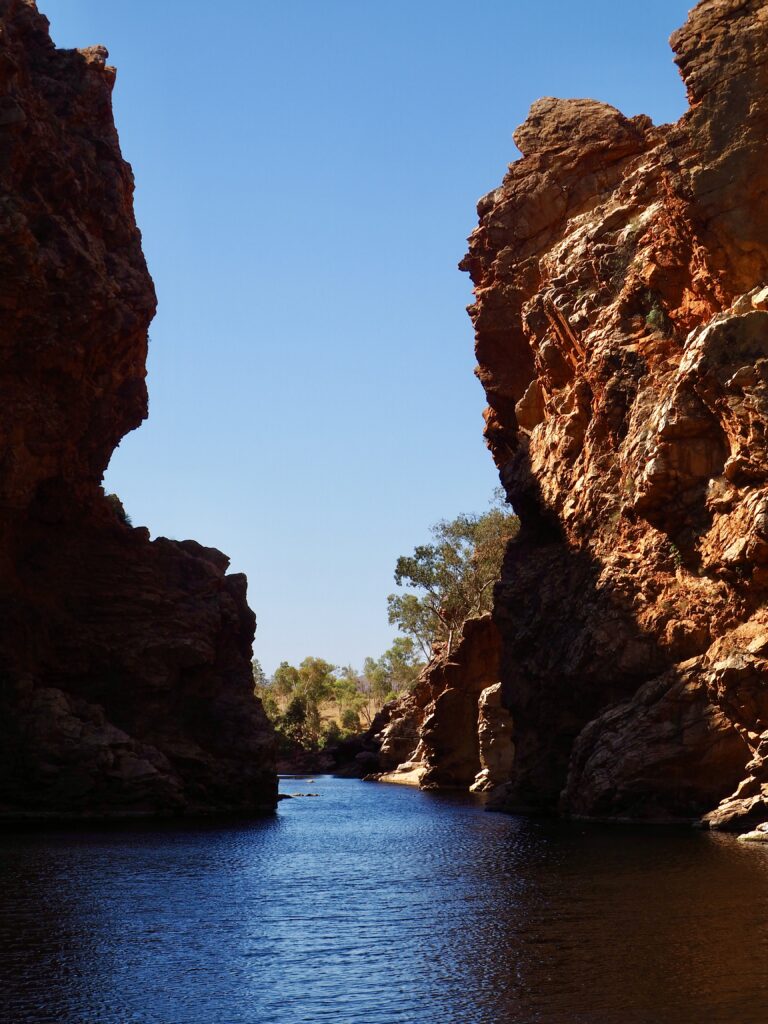
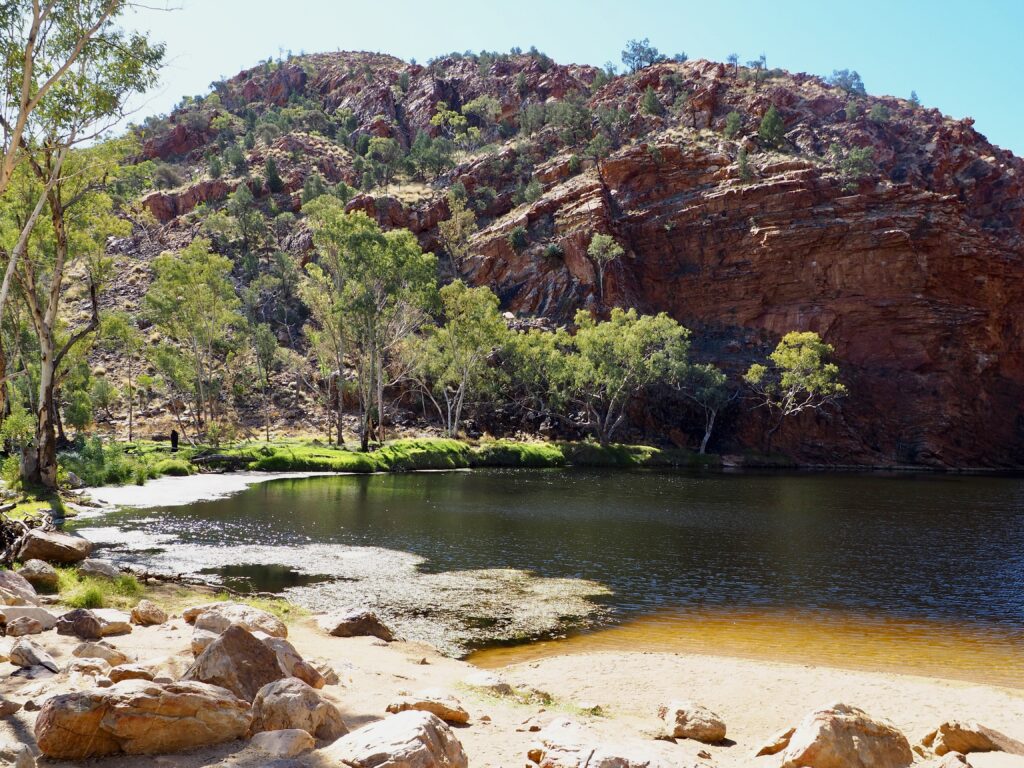
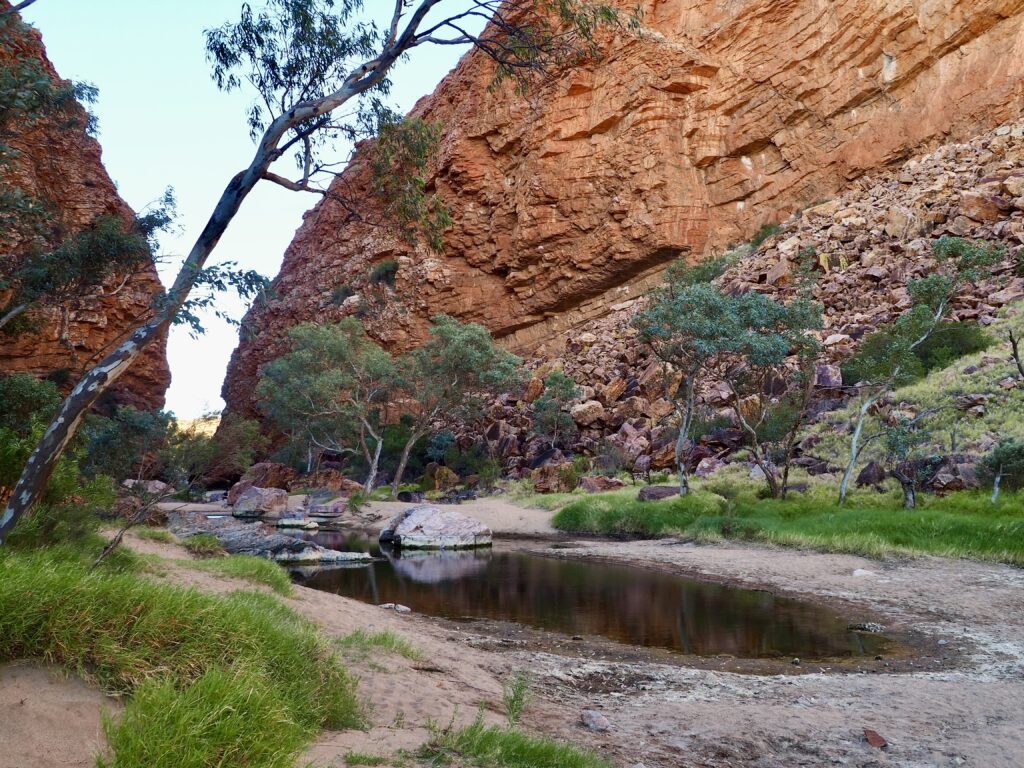
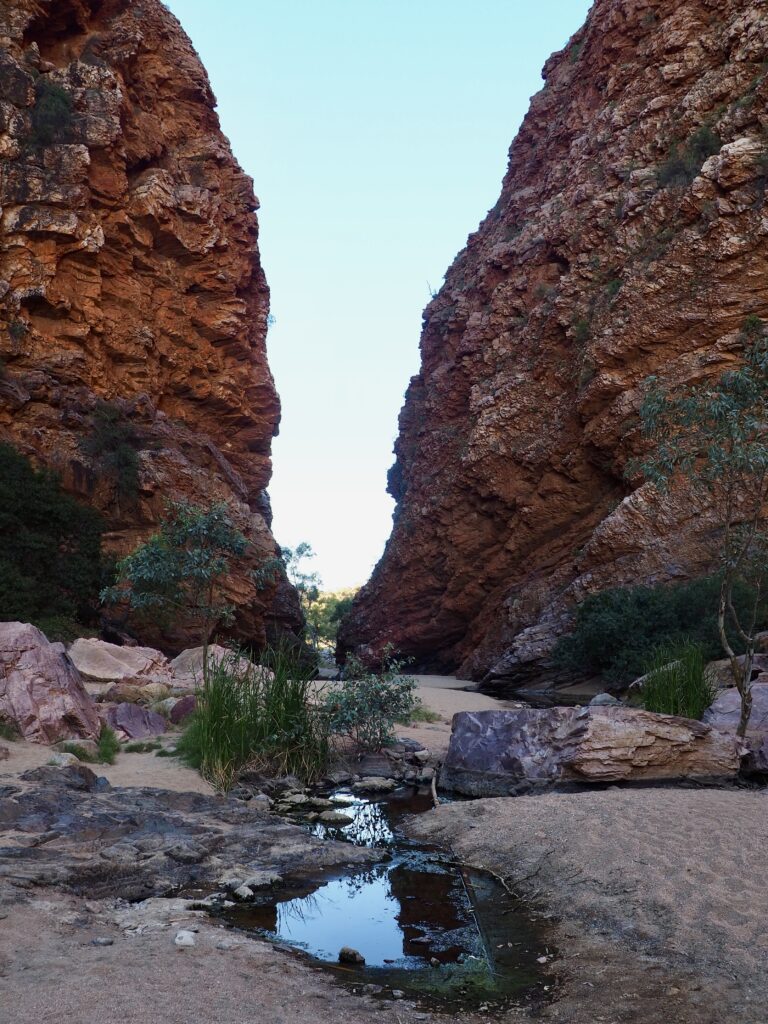
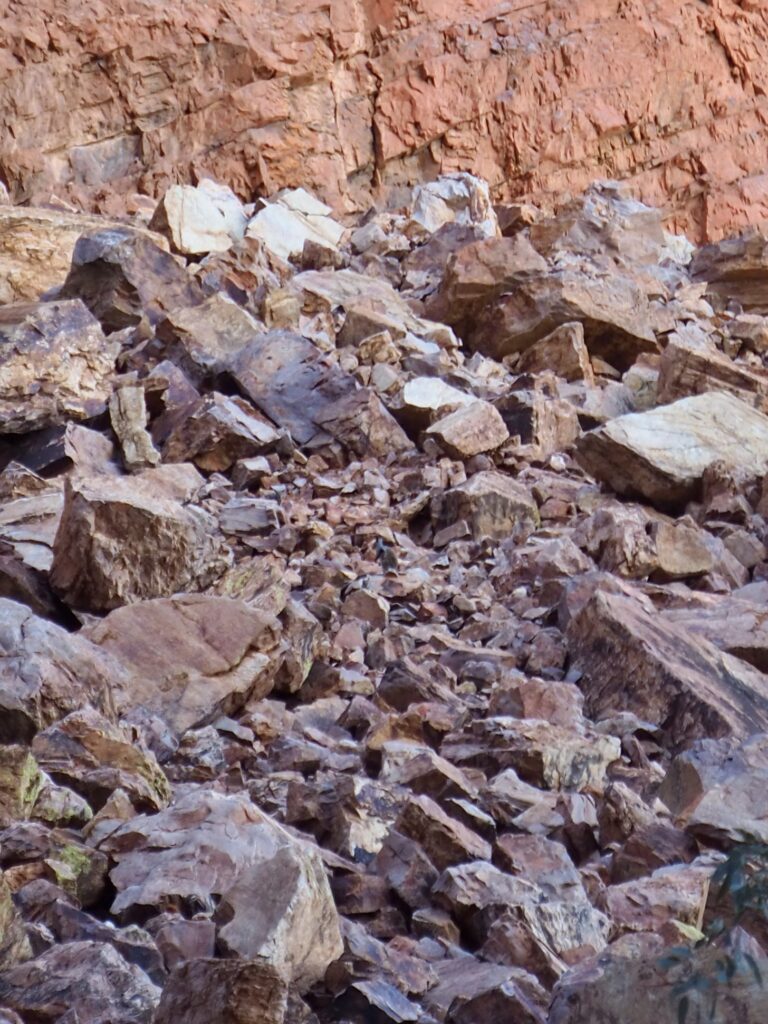
A Week in Australia’s Red Centre
I’m so glad when I planned out my Australia trip that I was able to include this week in the Red Centre! Yes, it involved a fair bit of flying to get there (I was headed back to Queensland next) since it’s so far from everything else. But it was totally worth it to get to experience a completely different side to Australia. It’s always quite surreal seeing an iconic sight like Uluru in person, and the rock is so impressive and magical!
And while you could just stay a couple of days to visit Uluru and nothing else, I’m glad I had a whole week in Australia’s Red Centre. The diversity of the landscapes in Kings Canyon and Tjoritja was an unexpected and very welcome surprise! I loved the array of colours throughout the trip – not just red and orange, but blue and green and purple and white too. And it was very humbling and reflective, being surrounded by such vast and ancient land forms. Learning about the prehistoric geology of how the land was formed, combined with the Aboriginal histories of the people who’ve lived here for millennia, just puts it all into perspective.
You May Also Like

Harry Potter Guide to Edinburgh
24 February 2018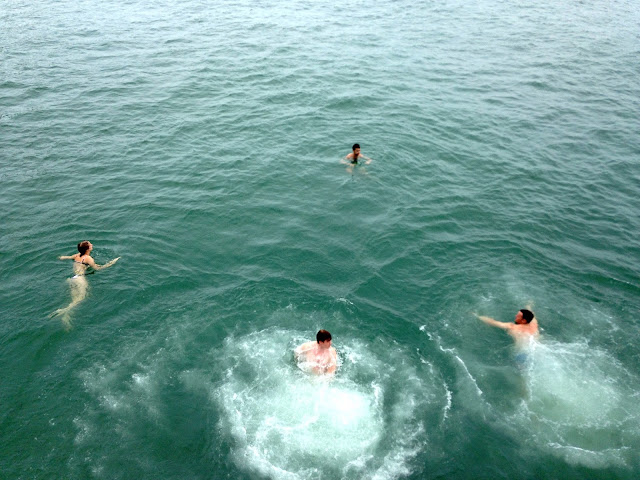
Junk Boat Party | Hong Kong
18 May 2016